Toyota Mirai (2020 year). Manual in english — part 7
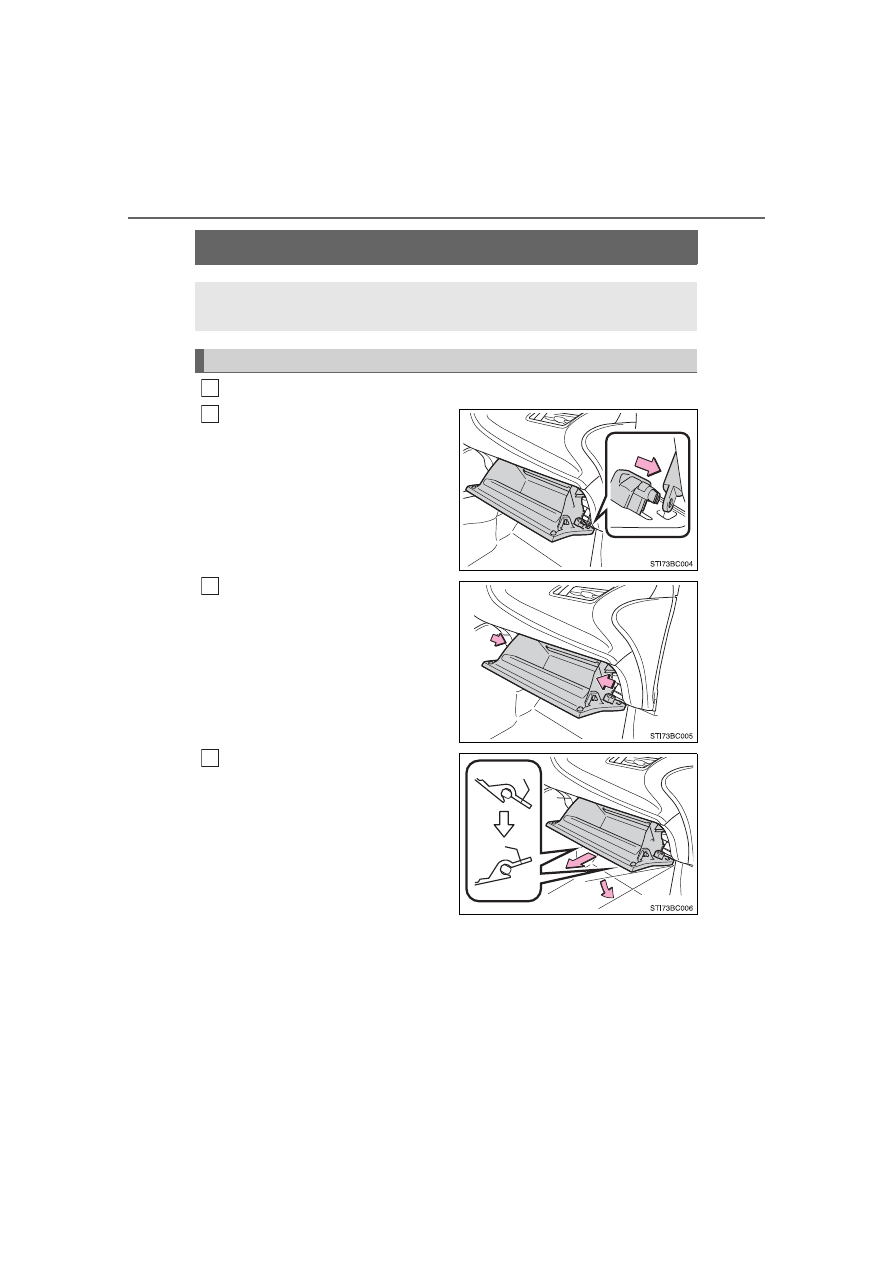
398
7-3. Do-it-yourself maintenance
MIRAI_OM_USA_OM62073U
Air conditioning filter
Turn the power switch off.
Open the glove box. Slide off
the damper.
Push the surface on the left
side of the glove box inward,
undo the upper left claw, then
push the surface on the right
side of the glove box inward
and undo the upper right claw.
Lower the glove box from the
completely open position, undo
the lower claws, and then
remove the glove box.
The air conditioning filter must be changed regularly to maintain
air conditioning efficiency.
Removal method
1
2
3
4
-------------------------------------------------------------------------------------------------------------------------------------------------------------
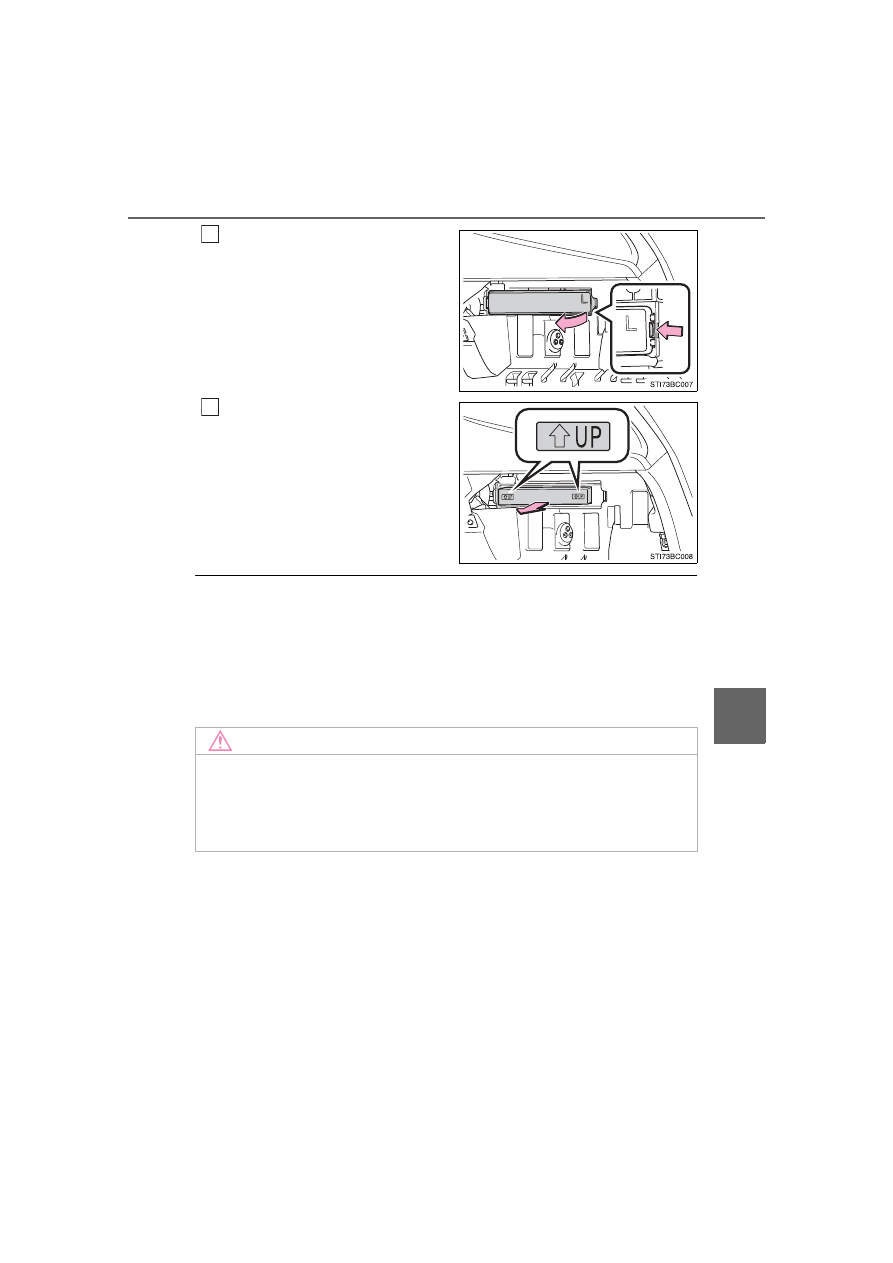
399
7-3. Do-it-yourself maintenance
MIRAI_OM_USA_OM62073U
7
Mainten
Remove the filter cover.
Remove the air conditioning fil-
ter and replace it with a new
one.
The “
UP” marks shown on the fil-
ter should be pointing up.
■
Checking interval
Inspect and replace the air conditioning filter according to the maintenance
schedule. In dusty areas or areas with heavy traffic flow, early replacement
may be required. (For scheduled maintenance information, please refer to the
“Schedule Maintenance Guide” or “Owner’s Manual Supplement”.)
■
If air flow from the vents decreases dramatically
The filter may be clogged. Check the filter and replace if necessary.
5
6
NOTICE
■
When using the air conditioning system
Make sure that a filter is always installed.
Using the air conditioning system without a filter may cause damage to the
system.
-------------------------------------------------------------------------------------------------------------------------------------------------------------

400
7-3. Do-it-yourself maintenance
MIRAI_OM_USA_OM62073U
Electronic key battery
●
Flathead screwdriver
●
Small flathead screwdriver
●
Lithium battery CR2032
Take out the mechanical key.
(
Remove the cover.
To prevent damage to the key,
cover the tip of the flathead screw-
driver with a rag.
Remove the depleted battery.
Insert a new battery with the “+”
terminal facing up.
Replace the battery with a new one if it is depleted.
You will need the following items:
Replacing the battery
1
2
3
-------------------------------------------------------------------------------------------------------------------------------------------------------------
401
7-3. Do-it-yourself maintenance
MIRAI_OM_USA_OM62073U
7
Mainten
■
Use a CR2032 lithium battery
●
Batteries can be purchased at your Toyota dealer, local electrical appliance
shops or camera stores.
●
Replace only with the same or equivalent type recommended by the manu-
facturer.
●
Dispose of used batteries according to local laws.
■
If the electronic key battery is depleted
The following symptoms may occur:
●
The smart key system and wireless remote control will not function properly.
●
The operational range will be reduced.
WARNING
■
Removed battery and other parts
These parts are small and if swallowed by a child, they can cause choking.
Keep away from children. Failure to do so could result in death or serious
injury.
NOTICE
■
For normal operation after replacing the battery
Observe the following precautions to prevent accidents:
●
Always work with dry hands.
Moisture may cause the battery to rust.
●
Do not touch or move any other component inside the remote control.
●
Do not bend either of the battery terminals.
-------------------------------------------------------------------------------------------------------------------------------------------------------------
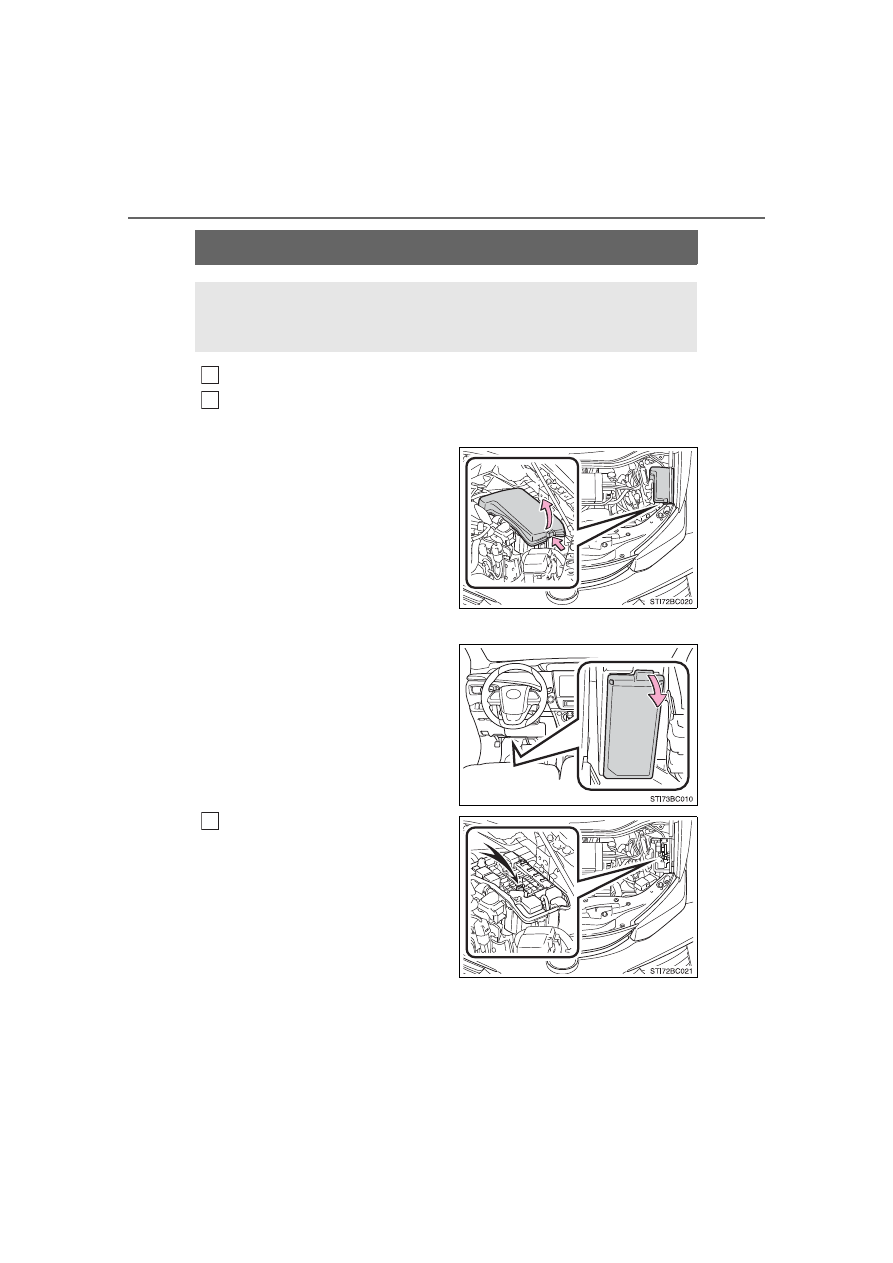
402
7-3. Do-it-yourself maintenance
MIRAI_OM_USA_OM62073U
Checking and replacing fuses
Turn the power switch off.
Open the fuse box cover.
Motor compartment
Push the tab in and lift the lid
off.
Driver’s side instrument panel
Remove the lid.
Remove the fuse with the pull-
out tool.
Only type A fuses can be removed
using the pullout tool.
If any of the electrical components do not operate, a fuse may
have blown. If this happens, check and replace the fuses as nec-
essary.
1
2
3
-------------------------------------------------------------------------------------------------------------------------------------------------------------

403
7-3. Do-it-yourself maintenance
MIRAI_OM_USA_OM62073U
7
Mainten
Check if the fuse is blown.
Normal fuse
Blown fuse
Replace the blown fuse with a new fuse of an appropriate amperage rat-
ing. The amperage rating can be found on the fuse box lid.
4
Type A
Type B
Type C
Type D
-------------------------------------------------------------------------------------------------------------------------------------------------------------
404
7-3. Do-it-yourself maintenance
MIRAI_OM_USA_OM62073U
■
After a fuse is replaced
●
If the lights do not turn on even after the fuse has been replaced, a bulb may
need replacement. (
●
If the replaced fuse blows again, have the vehicle inspected by your Toyota
dealer.
■
If there is an overload in a circuit
The fuses are designed to blow, protecting the wiring harness from damage.
WARNING
■
To prevent system breakdowns and vehicle fire
Observe the following precautions.
Failure to do so may cause damage to the vehicle, and possibly a fire or
injury.
●
Never use a fuse of a higher amperage rating than that indicated, or use
any other object in place of a fuse.
●
Always use a genuine Toyota fuse or equivalent.
Never replace a fuse with a wire, even as a temporary fix.
●
Do not modify the fuses or fuse boxes.
NOTICE
■
Before replacing fuses
Have the cause of electrical overload determined and repaired by your
Toyota dealer as soon as possible.
-------------------------------------------------------------------------------------------------------------------------------------------------------------
405
7-3. Do-it-yourself maintenance
MIRAI_OM_USA_OM62073U
7
Mainten
Light bulbs
■
LED light bulbs
The following lights consist of a number of LEDs. If any of the LEDs burn out,
take your vehicle to your Toyota dealer to have the light replaced.
●
Headlight low beams
●
Headlight high beams
●
Parking lights and daytime running lights
●
Front side marker lights
●
Front turn signal lights
●
Side turn signal lights
●
Tail lights
●
Stop lights
●
Rear side marker lights
●
Rear turn signal lights
●
High mounted stop lights
●
License plate lights
●
Back-up lights
■
Condensation build-up on the inside of the lens
Temporary condensation build-up on the inside of the headlight lens does not
indicate a malfunction.
Contact your Toyota dealer for more information in the following situations:
●
Large drops of water have built up on the inside of the lens.
●
Water has built up inside the headlight.
If any lights burn out, have it replaced by your Toyota dealer:
WARNING
■
Handling lights
Do not touch the lights while they are on or immediately after they have
been turned off. Doing so may result in burns.
-------------------------------------------------------------------------------------------------------------------------------------------------------------
-------------------------------------------------------------------------------------------------------------------------------------------------------------
407
8
When trouble arises
MIRAI_OM_USA_OM62073U
8-1. Essential information
Emergency flashers . . .. 408
If your vehicle has to
be stopped in an
emergency . . . . . .. 409
If the vehicle is trapped
in rising water. . . . .. 410
8-2. Steps to take in an
emergency
If your vehicle needs to
be towed . . . . . . . 411
If you think something is
wrong . . . . . . . .. 417
If a warning light turns on
or a warning buzzer
sounds . . . . . . . 418
If a warning message is
displayed. . . . . . . 426
If you have a flat tire. . .. 432
If the fuel cell system will
not start. . . . . . ... 447
If the electronic key does
not operate properly. . 449
If the 12-volt battery is
discharged . . . . . .. 452
If your vehicle overheats ... 457
If the vehicle becomes
stuck . . . . . . . ... 463
-------------------------------------------------------------------------------------------------------------------------------------------------------------
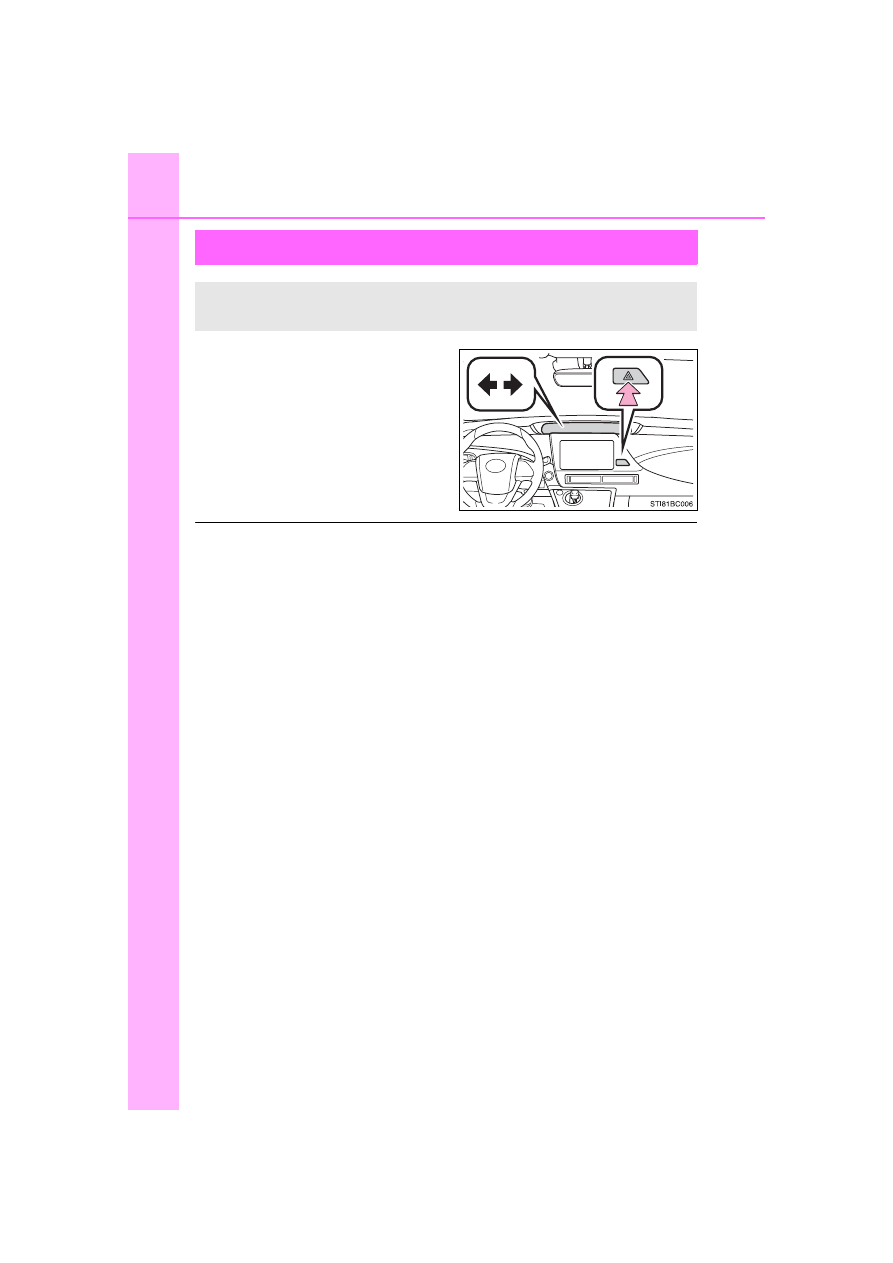
408
MIRAI_OM_USA_OM62073U
Emergency flashers
Press the switch.
All the turn signal lights will flash.
To turn them off, press the switch
once again.
■
Emergency flashers
If the emergency flashers are used for a long time while the fuel cell system is
not operating (while the “READY” indicator is not illuminated), the 12-volt bat-
tery may discharge.
The emergency flashers are used to warn other drivers when the
vehicle has to be stopped in the road due to a breakdown, etc.
-------------------------------------------------------------------------------------------------------------------------------------------------------------

409
MIRAI_OM_USA_OM62073U
8
Wh
en tro
If your vehicle has to be stopped in an
emergency
Steadily step on the brake pedal with both feet and firmly depress it.
Do not pump the brake pedal repeatedly as this will increase the effort
required to slow the vehicle.
Shift the shift position to N.
If the shift position is shifted to N
After slowing down, stop the vehicle in a safe place by the road.
Stop the fuel cell system.
If the shift position cannot be shifted to N
Keep depressing the brake pedal with both feet to reduce vehicle
speed as much as possible.
To stop the fuel cell system,
press and hold the power
switch for 2 consecutive sec-
onds or more, or press it briefly
3 times or more in succession.
Stop the vehicle in a safe place by the road.
Only in an emergency, such as if it becomes impossible to stop
the vehicle in the normal way, stop the vehicle using the follow-
ing procedure:
1
2
3
4
3
Press and hold for 2 seconds or more,
or press briefly 3 times or more
4
WARNING
■
If the fuel cell system has to be turned off while driving
Power assist for the steering wheel will be lost, making the steering wheel
heavier to turn. Decelerate as much as possible before turning off the fuel
cell system.
5
-------------------------------------------------------------------------------------------------------------------------------------------------------------
410
MIRAI_OM_USA_OM62073U
If the vehicle is trapped in rising water
●
Remove the seat belt first.
●
If the door can be opened, open the door and exit the vehicle.
●
If the door can not be opened, open the window using the power
window switch and exit the vehicle through the window.
●
If the window can not be opened using the power window switch,
remain calm, wait until the water level inside the vehicle rises to the
point that the water pressure inside of the vehicle equals the water
pressure outside of the vehicle, and then open the door and exit the
vehicle.
In the event the vehicle is submerged in water, remain calm and
perform the following.
WARNING
■
Using an emergency hammer
*
for emergency escape
The rear window of this vehicle can be shattered by an emergency ham-
mer
*
used for emergency escape, however, since the windshield, front side
windows and rear side windows are laminated glass they can not be shat-
tered by an emergency hammer
*
.
*
: Contact your Toyota dealer or aftermarket accessory manufacturer for fur-
ther information about an emergency hammer.
■
Escaping the vehicle from the window
There are cases where escaping the vehicle from the window is not possi-
ble due to seating position, passenger body type, etc.
When using an emergency hammer, consider your seat location and the
size of the window opening to ensure that the opening is accessible and
large enough to escape.
-------------------------------------------------------------------------------------------------------------------------------------------------------------
411
8-2. Steps to take in an emergency
MIRAI_OM_USA_OM62073U
8
Wh
en tro
If your vehicle needs to be towed
In the following situations, it is not possible to be towed by another
vehicle using cables or chains, as the front wheels may be locked due
to the parking lock. Contact your Toyota dealer or commercial towing
service.
●
There is a malfunction in the shift control system. (
●
There is a malfunction in the immobilizer system. (
●
There is a malfunction in the smart key system. (
●
The 12-volt battery is discharged. (
If towing is necessary, we recommend having your vehicle
towed by your Toyota dealer or commercial towing service,
using a wheel-lift type truck or flatbed truck.
Use a safety chain system for all towing, and abide by all state/
provincial and local laws.
Situations when it is not possible to be towed by another vehicle
-------------------------------------------------------------------------------------------------------------------------------------------------------------
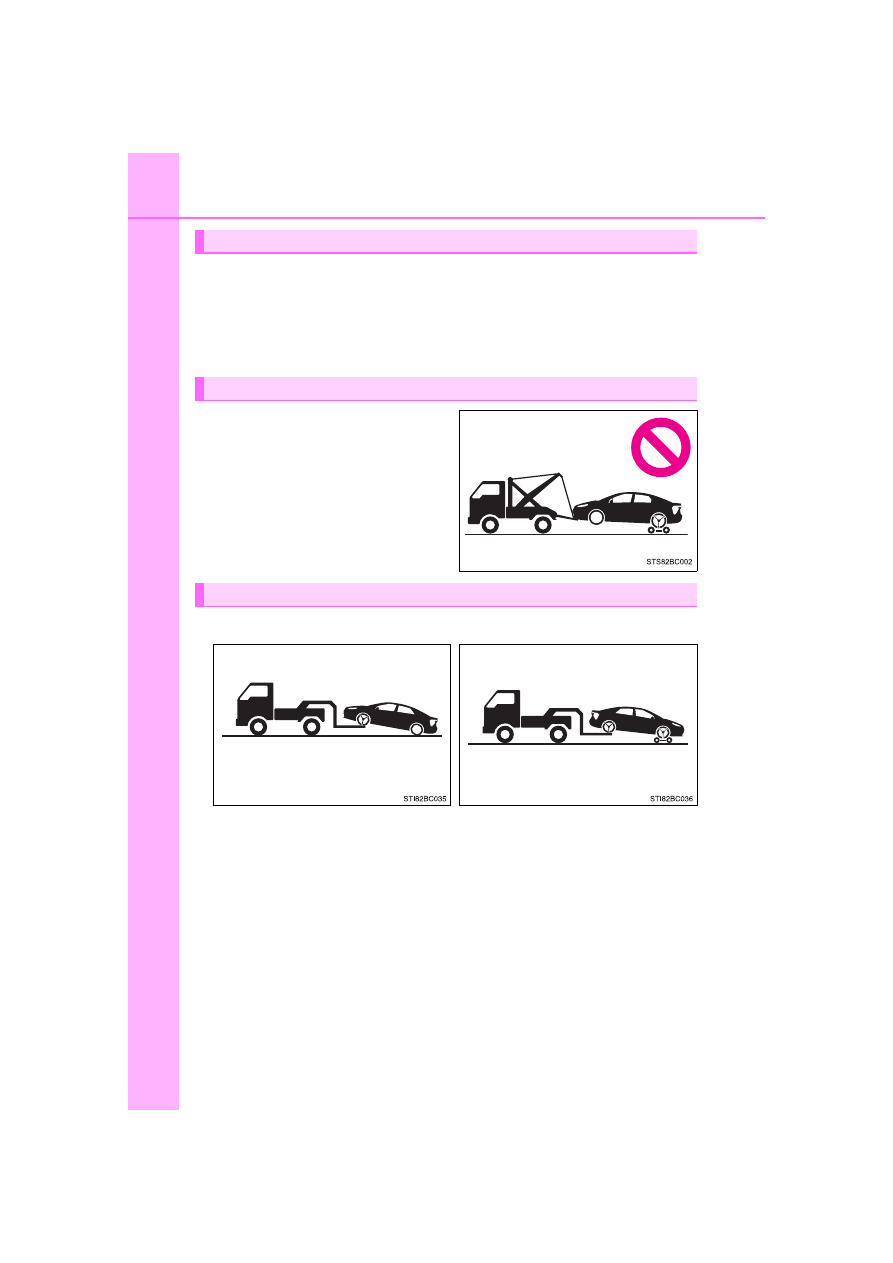
412
8-2. Steps to take in an emergency
MIRAI_OM_USA_OM62073U
The following may indicate a problem with your transmission. Contact
your Toyota dealer or commercial towing service before towing.
●
The fuel cell system warning message shows on the multi-informa-
tion display and the vehicle does not move.
●
The vehicle makes an abnormal sound.
Do not tow with a sling-type truck
to prevent body damage.
Situations when it is necessary to contact dealers before towing
Towing with a sling-type truck
Towing with a wheel-lift type truck
From the front
From the rear
Release the parking brake.
Use a towing dolly under the
front wheels.
-------------------------------------------------------------------------------------------------------------------------------------------------------------
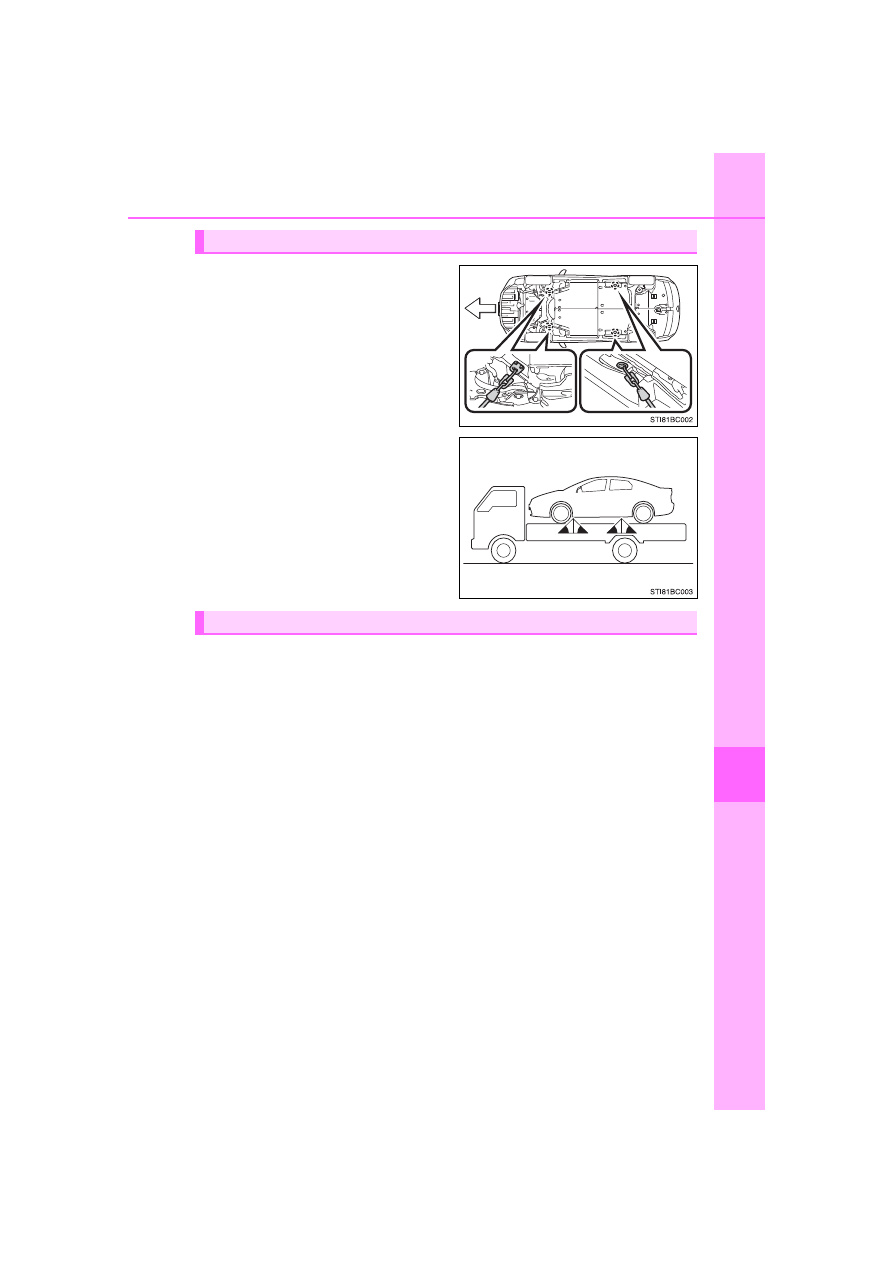
413
8-2. Steps to take in an emergency
MIRAI_OM_USA_OM62073U
8
Wh
en tro
If your vehicle is transported by a
flatbed truck, it should be tied
down at the locations shown in the
illustration.
If you use chains or cables to tie
down your vehicle, the angles
shaded in black must be 45
.
Do not overly tighten the tie
downs or the vehicle may be dam-
aged.
If a tow truck is not available in an emergency, your vehicle may be
temporarily towed using cables or chains secured to the emergency
towing eyelets. This should only be attempted on hard surfaced roads
for a short distance at under 18 mph (30 km/h).
A driver must be in the vehicle to steer and operate the brakes. The
vehicle’s wheels, drivetrain, axles, steering and brakes must be in
good condition.
Using a flatbed truck
Front
Emergency towing
-------------------------------------------------------------------------------------------------------------------------------------------------------------

414
8-2. Steps to take in an emergency
MIRAI_OM_USA_OM62073U
Take out the towing eyelet. (
Remove the eyelet cover using a flathead screwdriver.
To protect the bodywork, place a rag between the screwdriver and the
vehicle body as shown in the illustration.
Insert the towing eyelet into the
hole and tighten partially by
hand.
Tighten down the towing eyelet
securely using a wheel nut
wrench or hard metal bar.
Securely attach cables or chains to the towing eyelet.
Take care not to damage the vehicle body.
Enter the vehicle being towed and start the fuel cell system.
If the fuel cell system does not start, turn the power switch to ON mode.
Turn off the Parking Support Brake function (for static objects) (if
equipped).: →P. 276
Shift the shift position to N and release the parking brake.
Emergency towing procedure
1
2
Front
Rear
3
4
5
6
7
-------------------------------------------------------------------------------------------------------------------------------------------------------------
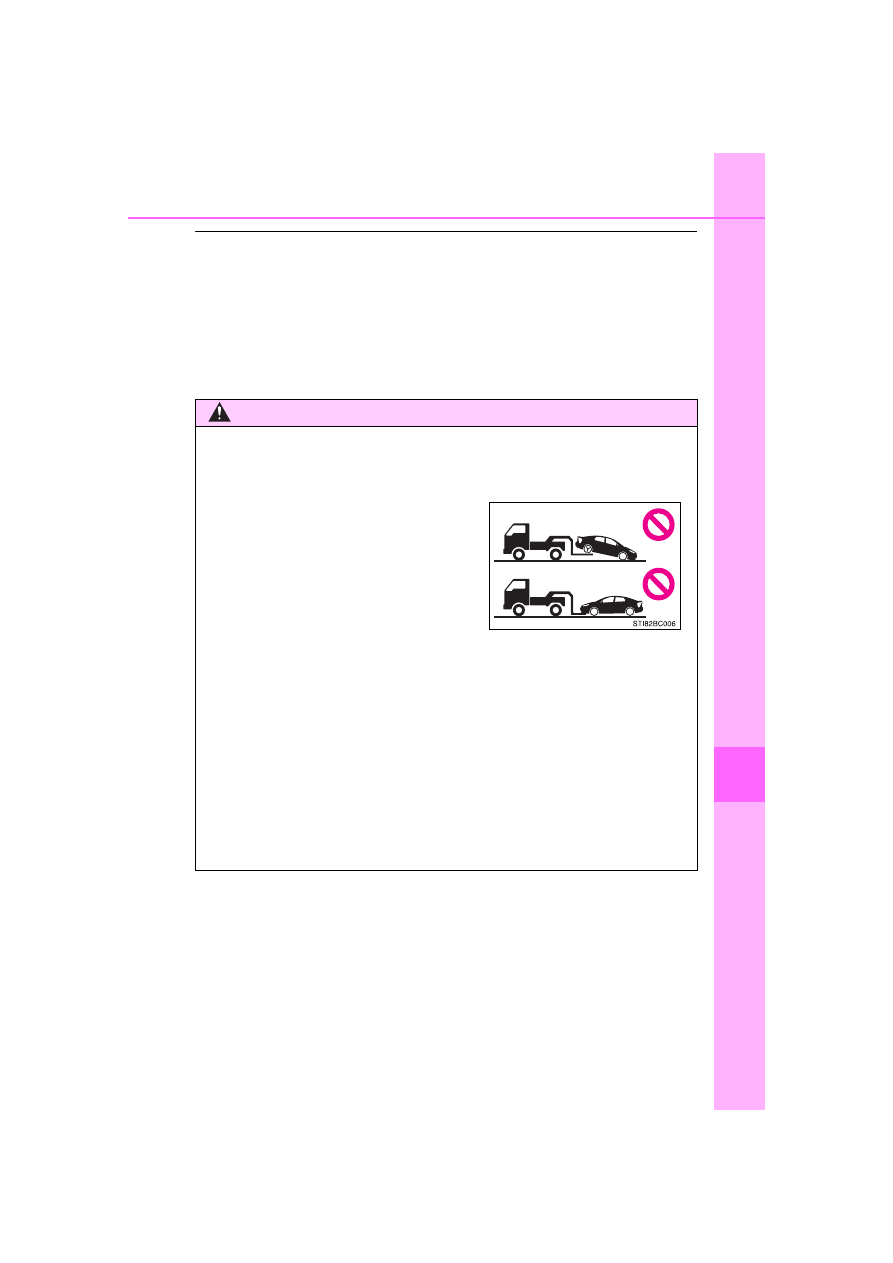
415
8-2. Steps to take in an emergency
MIRAI_OM_USA_OM62073U
8
Wh
en tro
■
While towing
If the fuel cell system is off, the power assist for the brakes and steering will
not function, making steering and braking more difficult.
■
Wheel nut wrench
Wheel nut wrench is installed in trunk. (
■
Before transporting or towing in frozen areas
Operate the water release function. Otherwise, the fuel cell system may
freeze and the vehicle may not be able to be started. (
WARNING
Observe the following precautions.
Failure to do so may result in death or serious injury.
■
When towing the vehicle
■
While towing
●
When towing using cables or chains, avoid sudden starts, etc., which
place excessive stress on the towing eyelets, cables or chains. The towing
eyelets, cables or chains may become damaged, broken debris may hit
people, and cause serious damage.
●
Do not turn the power switch off.
This may lead to an accident as the front wheels will be locked by the
parking lock.
■
Installing towing eyelets to the vehicle
Make sure that towing eyelets are installed securely.
If not securely installed, towing eyelets may come loose during towing.
Be sure to transport the vehicle with the
front wheels raised or with all four wheels
raised off the ground. If the vehicle is
towed with the front wheels contacting
the ground, the drivetrain and related
parts may be damaged or electricity gen-
erated by the operation of the motor may
cause a fire to occur depending on the
nature of the damage or malfunction.
-------------------------------------------------------------------------------------------------------------------------------------------------------------
416
8-2. Steps to take in an emergency
MIRAI_OM_USA_OM62073U
NOTICE
■
To prevent damage to the vehicle when towing using a wheel-lift type
truck
When raising the vehicle, ensure adequate ground clearance for towing at
the opposite end of the raised vehicle. Without adequate clearance, the
vehicle could be damaged while being towed.
■
To prevent damage to the vehicle when towing with a sling-type truck
Do not tow with a sling-type truck, either from the front or rear.
■
To prevent damage to the vehicle during emergency towing
Do not secure cables or chains to the suspension components.
-------------------------------------------------------------------------------------------------------------------------------------------------------------

417
8-2. Steps to take in an emergency
MIRAI_OM_USA_OM62073U
8
Wh
en tro
If you think something is wrong
●
Fluid leaks under the vehicle.
(Water dripping from the air conditioning after use is normal.)
●
Flat-looking tires or uneven tire wear
●
The high coolant temperature warning light flashes or comes on
●
Excessive tire squeal when cornering
●
Strange noises related to the suspension system
●
Pinging or other noises related to the fuel cell system
●
Stumbling or running roughly
●
Appreciable loss of power
●
Vehicle pulls heavily to one side when braking
●
Vehicle pulls heavily to one side when driving on a level road
●
Loss of brake effectiveness, spongy feeling, pedal almost touches
the floor
If you notice any of the following symptoms, your vehicle proba-
bly needs adjustment or repair. Contact your Toyota dealer as
soon as possible.
Visible symptoms
Audible symptoms
Operational symptoms
-------------------------------------------------------------------------------------------------------------------------------------------------------------
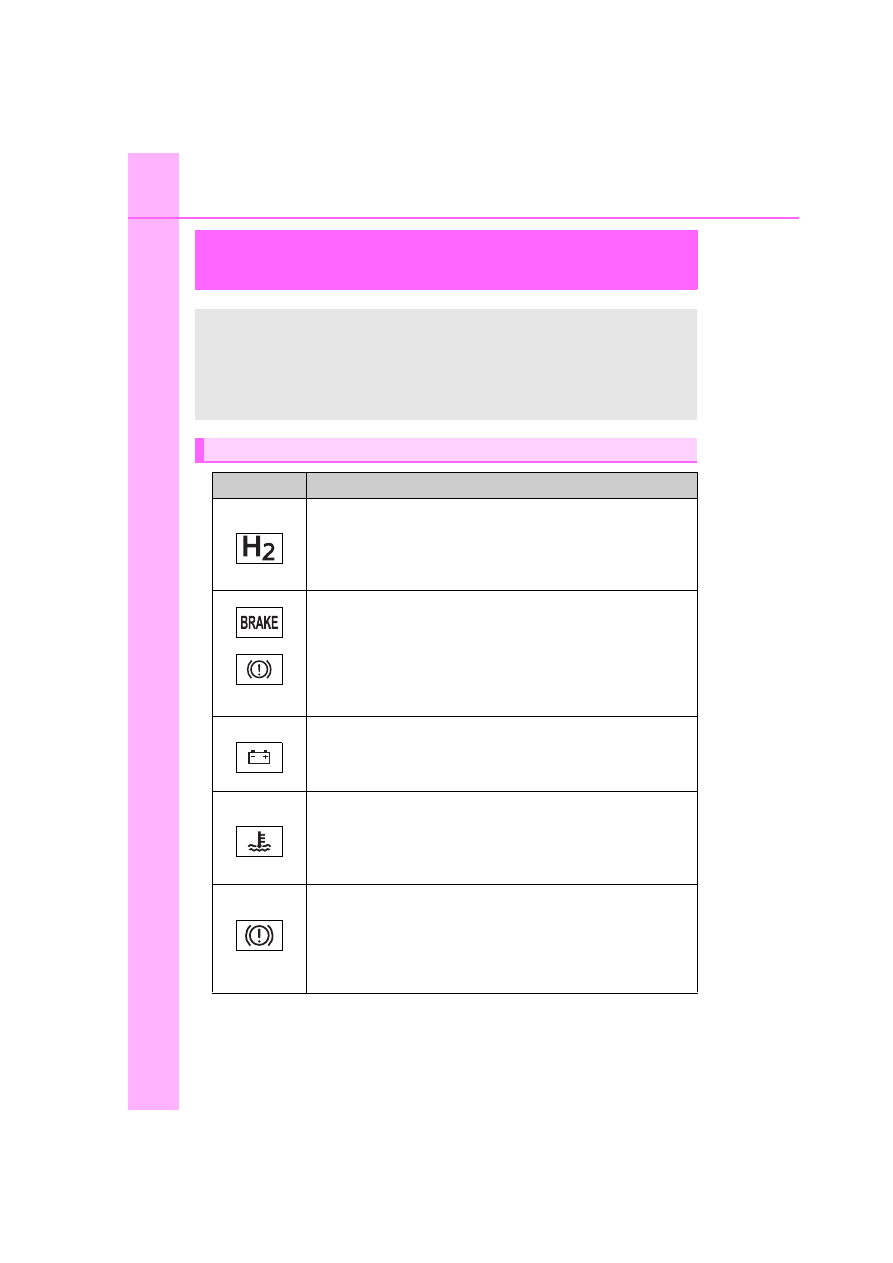
418
8-2. Steps to take in an emergency
MIRAI_OM_USA_OM62073U
If a warning light turns on or a warning
buzzer sounds
Calmly perform the following actions if any of the warning lights
comes on or flashes. If a light comes on or flashes, but then
goes off, this does not necessarily indicate a malfunction in the
system. However, if this continues to occur, have the vehicle
inspected by your Toyota dealer.
Warning light and warning buzzer list
Warning light
Warning light/Details/Actions
Hydrogen leak warning light (warning buzzer)
When a hydrogen gas leak is detected, a buzzer sounds,
a light comes on, and a warning message is displayed on
the multi-information display.
(U.S.A.)
(Red)
(Canada)
Brake system warning light (warning buzzer)
*
1
Indicates that:
• The brake fluid level is low; or
• The brake system is malfunctioning
Immediately stop the vehicle in a safe place and con-
tact your Toyota dealer. Continuing to drive the vehi-
cle may be dangerous.
Charging system warning light
Indicates a malfunction in the vehicle’s charging system
Immediately stop the vehicle in a safe place and con-
tact your Toyota dealer.
High coolant temperature warning light
Indicates that the coolant temperature is abnormal
Immediately stop the vehicle in a safe place and con-
tact your Toyota dealer.
(Yellow)
Brake system warning light
Indicates a malfunction in:
• The regenerative braking system; or
• The electronically controlled brake system
Have the vehicle inspected by your Toyota dealer
immediately.
-------------------------------------------------------------------------------------------------------------------------------------------------------------

419
8-2. Steps to take in an emergency
MIRAI_OM_USA_OM62073U
8
Wh
en tro
SRS warning light
Indicates a malfunction in:
• The SRS airbag system;
• The front passenger occupant classification system; or
• The seat belt pretensioner system
Have the vehicle inspected by your Toyota dealer
immediately.
(U.S.A.)
(Canada)
ABS warning light
Indicates a malfunction in:
• The ABS; or
• The brake assist system
Have the vehicle inspected by your Toyota dealer
immediately.
(Red/Yellow)
Electric power steering system warning light (warning
buzzer)
Indicates a malfunction in the EPS (Electric Power Steer-
ing) system
Have the vehicle inspected by your Toyota dealer
immediately.
(Yellow)
LDA indicator (warning buzzer)
Indicates a malfunction in the LDA (Lane Departure Alert)
Follow the instructions displayed on the multi-infor-
mation display. (
(Flashes)
PKSB OFF indicator (warning buzzer)
When a buzzer sounds:
Indicates a malfunction in the Parking Support Brake func-
tion (for static objects)
Have the vehicle inspected by your Toyota dealer
immediately.
When a buzzer does not sound:
Indicates that the system is temporarily unavailable, possi-
bly due to a sensor being dirty or covered with ice, etc.
Clear the dirt, etc.
When removing and installing the 12-volt battery, the sys-
tem needs to be initialized.
Warning light
Warning light/Details/Actions
-------------------------------------------------------------------------------------------------------------------------------------------------------------

420
8-2. Steps to take in an emergency
MIRAI_OM_USA_OM62073U
(Flashes or
illuminates)
PCS warning light
When a buzzer sounds simultaneously:
Indicates a malfunction has occurred in the PCS (Pre-Col-
lision System).
Have the vehicle inspected by your Toyota dealer
immediately.
When a buzzer does not sound:
The PCS (Pre-Collision System) has become temporarily
unavailable, corrective action may be necessary.
Follow the instructions displayed on the multi-infor-
mation display. (
If the PCS (Pre-Collision System) or VSC (Vehicle Stability
Control) system is disabled, the PCS warning light will illu-
minate.
Slip indicator
Indicates a malfunction in:
• The VSC system;
• The TRAC system; or
• The hill-start assist control system
The light will flash when the ABS, VSC or TRAC
system is
operating.
Have the vehicle inspected by your Toyota dealer
immediately.
(U.S.A.)
(Canada)
Parking brake warning light (warning buzzer)
*
2
Parking brake has not been fully released
Operate the parking brake once again.
If the light turns off after the parking brake is fully released,
the system is operating normally.
Open door warning light (warning buzzer)
*
3
Indicates that a door or the trunk is not fully closed
Check that all the doors and the trunk are closed.
Low fuel level warning light
Indicates that remaining fuel is approximately 2.4 lb.
(1.1 kg) or less
Refuel the vehicle.
Warning light
Warning light/Details/Actions
-------------------------------------------------------------------------------------------------------------------------------------------------------------
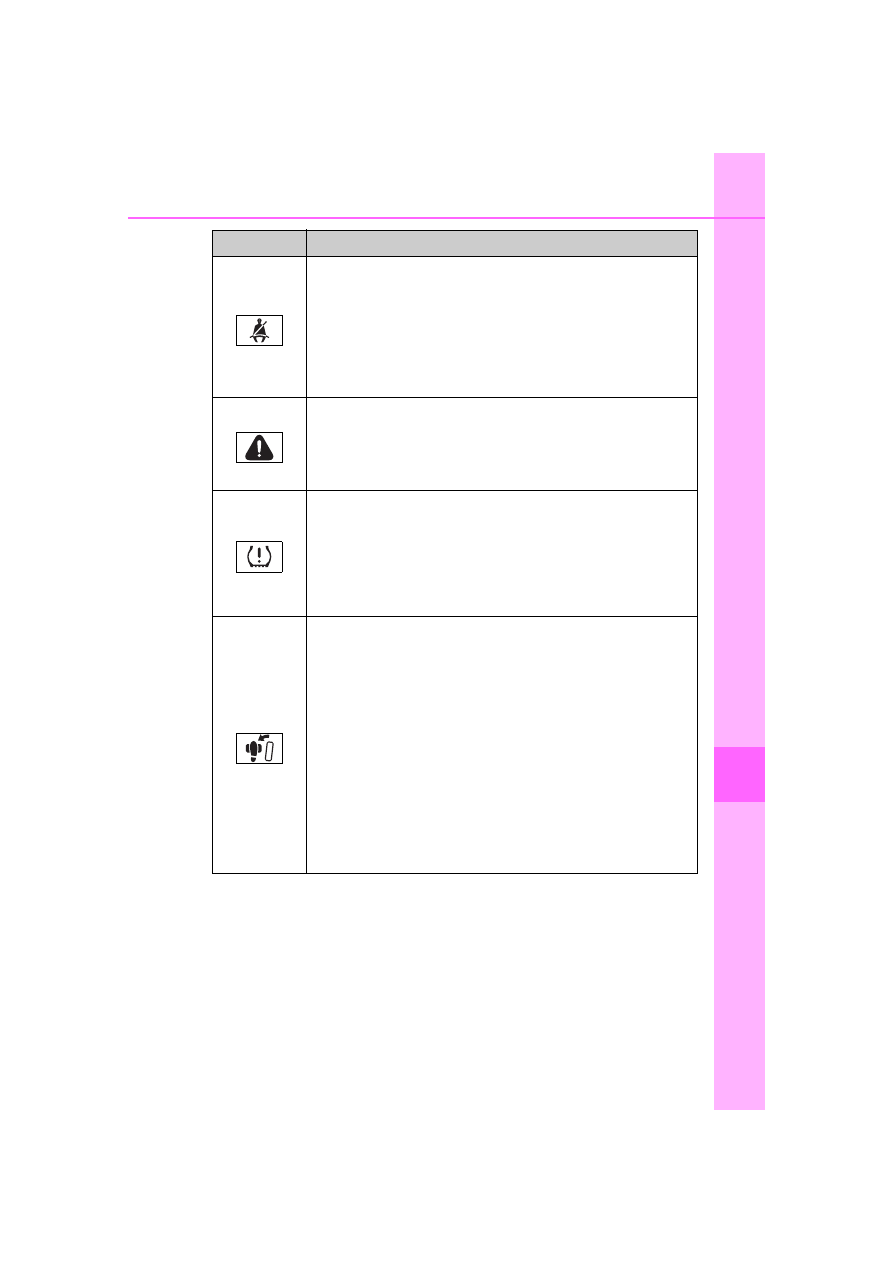
421
8-2. Steps to take in an emergency
MIRAI_OM_USA_OM62073U
8
Wh
en tro
*
1
: Brake warning buzzer:
When there is a malfunction that leads to a decline in the brake effective-
ness, a buzzer sounds while at the same time a warning light comes on.
*
2
: Parking brake engaged warning buzzer:
*
3
: Open door warning buzzer:
A buzzer will sound if the vehicle reaches a speed of 3 mph (5 km/h) or
more with any door open.
Driver’s and front passenger’s seat belt reminder light
(warning buzzer)
*
4
Warns the driver and/or front passenger to fasten their
seat belts
Fasten the seat belt.
If the front passenger’s seat is occupied, the front
passenger’s seat belt also needs to be fastened to
make the warning light (warning buzzer) turn off.
Master warning light
A buzzer sounds and the warning light comes on and
flashes to indicate that the master warning system has
detected a malfunction.
Tire pressure warning light
Indicates low tire pressure due to one of the following:
• Flat tire
• Natural causes
• The tire pressure warning system is malfunctioning
Immediately stop the vehicle in a safe place.
Handling method (
Brake Override System/Drive-Start Control/Parking Sup-
port Brake function (for static objects) (if equipped)
*
5
Indicates that:
• The Brake Override System is operating;
• The Brake Override System is malfunctioning (with
warning buzzer);
• The Drive-Start Control is operating (with warning
buzzer);
• The Drive-Start Control is malfunctioning (with warning
buzzer); or
• The Parking Support Brake function (for static objects)
(if equipped) is operating (with warning buzzer)
(
Follow the instruction that are displayed on the multi-
information display.
Warning light
Warning light/Details/Actions
-------------------------------------------------------------------------------------------------------------------------------------------------------------
422
8-2. Steps to take in an emergency
MIRAI_OM_USA_OM62073U
*
4
: Driver’s and front passenger’s seat belt warning buzzer:
The driver’s seat belt warning buzzer sounds to alert the driver that his or
her seat belt is not fastened. Once the power switch is turned to ON mode,
the buzzer sounds for 6 seconds. If the vehicle reaches a speed of 12 mph
(20 km/h), the buzzer sounds once. If the seat belt is still unfastened after
24 seconds, the buzzer will sound intermittently for 10 seconds. Then, if
the seat belt is still unfastened, the buzzer will sound in a different tone for
20 more seconds.
The front passenger’s seat belt warning buzzer sounds to alert the front
passenger that his or her seat belt is not fastened. The buzzer sounds
once if the vehicle reaches a speed of 12 mph (20 km/h). If the seat belt is
still unfastened after 24 seconds, the buzzer will sound intermittently for
10 seconds. Then, if the seat belt is still unfastened, the buzzer will sound
in a different tone for 20 more seconds.
*
5
: This light illuminates on the multi-information display.
-------------------------------------------------------------------------------------------------------------------------------------------------------------
423
8-2. Steps to take in an emergency
MIRAI_OM_USA_OM62073U
8
Wh
en tro
■
SRS warning light
This warning light system monitors the airbag sensor assembly, front impact
sensors, side impact sensors (front door), side impact sensors (front), side
impact sensors (rear), driver’s seat position sensor, driver’s seat belt buckle
switch, front passenger occupant classification system (ECU and sensors),
“AIR BAG ON” indicator light, “AIR BAG OFF” indicator light, front passen-
ger’s seat belt buckle switch, seat belt pretensioners, airbags, interconnect-
ing wiring and power sources. (
■
Front passenger detection sensor, seat belt reminder and warning
buzzer
●
If luggage is placed on the front passenger seat, the front passenger detec-
tion sensor may cause the warning light to flash and the warning buzzer to
sound even if a passenger is not sitting in the seat.
●
If a cushion is placed on the seat, the sensor may not detect a passenger,
and the warning light may not operate properly.
■
Electric power steering system warning light (warning buzzer)
When the 12-volt battery charge becomes insufficient or the voltage tempo-
rarily drops, the electric power steering system warning light may come on
and the warning buzzer may sound.
■
When the tire pressure warning light comes on
Inspect the appearance of the tire to check that the tire is not punctured.
If the tire is punctured:
If the tire is not punctured:
After turning the power switch to off, turn it to ON mode again and make
sure the tire pressure warning light comes on or blinks.
The tire pressure warning light comes on
After the temperature of the tires have lowered sufficiently, check the
tire inflation pressure and adjust it to the specified level.
If the warning light does not go out even after several minutes, check
that the tire inflation pressure is at the specified level.
If the warning light does not go out even after several minutes, have the
vehicle inspected by your Toyota dealer immediately.
The tire pressure warning light is blinking for 1 minute, and then comes
on
Malfunction in the tire pressure warning system. Have the system
checked by your Toyota dealer immediately.
■
The tire pressure warning light may come on due to natural causes
The tire pressure warning light may come on due to natural causes such
as natural air leaks and tire inflation pressure changes caused by tem-
perature. In this case, adjusting the tire inflation pressure will turn off the
warning light (after a few minutes).
■
Conditions that the tire pressure warning system may not function
properly
1
2
-------------------------------------------------------------------------------------------------------------------------------------------------------------
424
8-2. Steps to take in an emergency
MIRAI_OM_USA_OM62073U
■
Warning buzzer
In some cases, the buzzer may not be heard due to being in a noisy location
or audio sound.
WARNING
■
If both the ABS and the brake system warning lights remain on
Stop your vehicle in a safe place immediately and contact your Toyota
dealer. The vehicle will become extremely unstable during braking, and the
ABS system may fail, which could cause an accident resulting in death or
serious injury.
■
When the electric power steering system warning light comes on
When the light comes on yellow, the assist to the power steering is
restricted. When the light comes on red, the assist to the power steering is
lost and handling operations of the steering wheel become extremely
heavy. When steering wheel operations are heavier than usual, grip the
steering wheel firmly and operate it using more force than usual.
■
If the tire pressure warning light comes on
Handling method (
Be sure to observe the following precautions. Failure to do so could
cause a loss of vehicle control and result in death or serious injury.
●
Stop your vehicle in a safe place as soon as possible. Adjust the tire
inflation pressure immediately.
●
If the tire pressure warning light comes on even after tire inflation pres-
sure adjustment, it is probable that you have a flat tire. Check the tires.
If a tire is flat, repair the flat tire by using emergency tire puncture
repair kit.
●
Avoid abrupt maneuvering and braking. If the vehicle tires deteriorate,
you could lose control of the steering wheel or the brakes.
■
If a blowout or sudden air leakage should occur
The tire pressure warning system may not activate immediately.
-------------------------------------------------------------------------------------------------------------------------------------------------------------
425
8-2. Steps to take in an emergency
MIRAI_OM_USA_OM62073U
8
Wh
en tro
WARNING
■
Maintenance of the tires
Each tire, including the spare (if provided), should be checked monthly
when cold and inflated to the inflation pressure recommended by the
vehicle manufacturer on the vehicle placard or tire inflation pressure
label (tire and load information label). (If your vehicle has tires of a dif-
ferent size than the size indicated on the vehicle placard or tire inflation
pressure label [tire and load information label], you should determine
the proper tire inflation pressure for those tires.)
As an added safety feature, your vehicle has been equipped with a tire
pressure monitoring system (TPMS-tire pressure warning system) that
illuminates a low tire pressure telltale (tire pressure warning light) when
one or more of your tires is significantly under-inflated. Accordingly,
when the low tire pressure telltale (tire pressure warning light) illumi-
nates, you should stop and check your tires as soon as possible, and
inflate them to the proper pressure. Driving on a significantly under-
inflated tire causes the tire to overheat and can lead to tire failure.
Under-inflation also reduces fuel efficiency and tire tread life, and may
affect the vehicle’s handling and stopping ability.
Please note that the TPMS (tire pressure warning system) is not a sub-
stitute for proper tire maintenance, and it is the driver’s responsibility to
maintain correct tire pressure, even if under-inflation has not reached
the level to trigger illumination of the TPMS low tire pressure telltale (tire
pressure warning light).
Your vehicle has also been equipped with a TPMS (tire pressure warn-
ing system) malfunction indicator to indicate when the system is not
operating properly. The TPMS (tire pressure warning system) malfunc-
tion indicator is combined with the low tire pressure telltale (tire pressure
warning light). When the system detects a malfunction, the telltale will
flash for approximately one minute and then remain continuously illumi-
nated. This sequence will continue upon subsequent vehicle start-ups
as long as the malfunction exists. When the malfunction indicator is illu-
minated, the system may not be able to detect or signal low tire pres-
sure as intended.
TPMS (tire pressure warning system) malfunctions may occur for a vari-
ety of reasons, including the installation of replacement or alternate tires
or wheels on the vehicle that prevent the TPMS (tire pressure warning
system) from functioning properly. Always check the TPMS (tire pres-
sure warning system) malfunction telltale after replacing one or more
tires or wheels on your vehicle to ensure that the replacement or alter-
nate tires and wheels allow the TPMS (tire pressure warning system) to
continue to function properly.
-------------------------------------------------------------------------------------------------------------------------------------------------------------
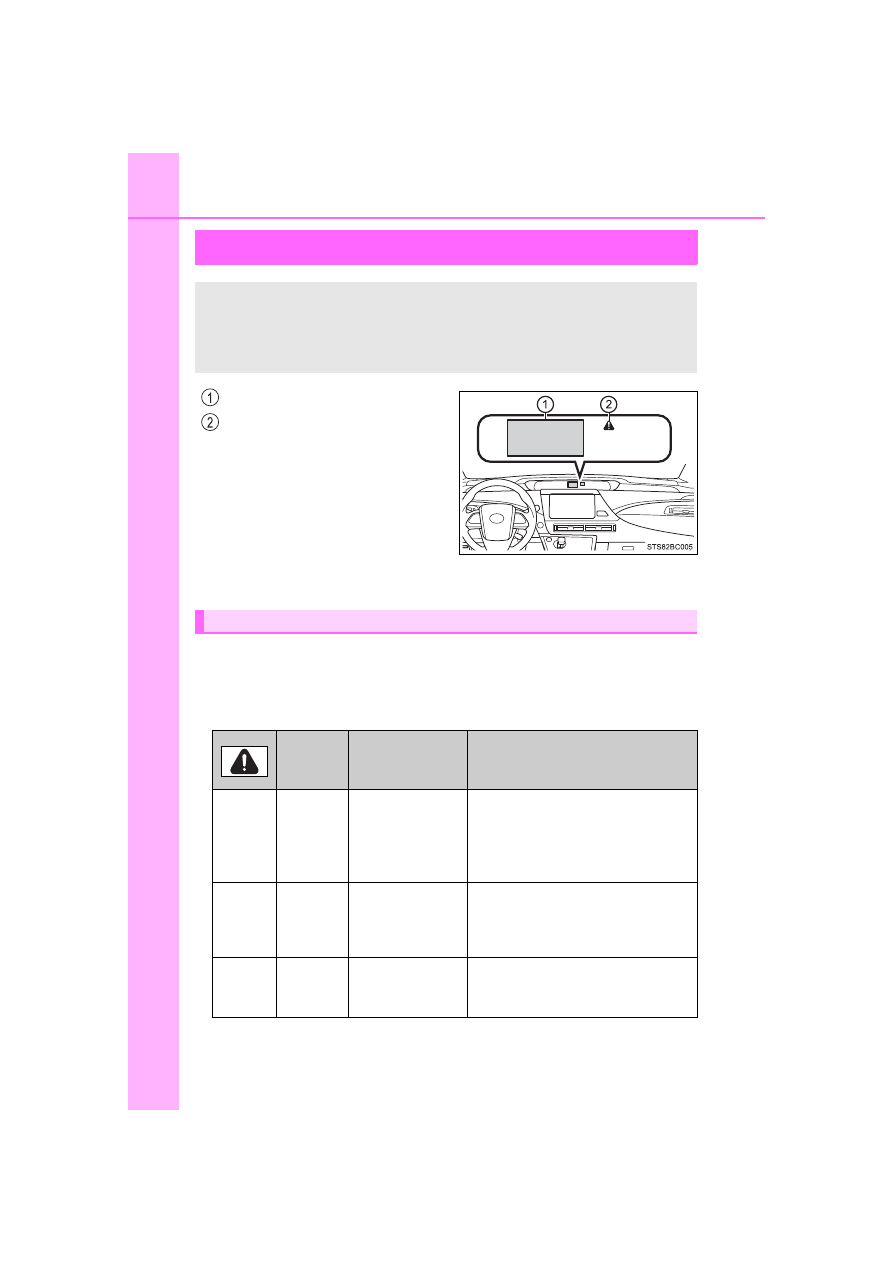
426
8-2. Steps to take in an emergency
MIRAI_OM_USA_OM62073U
If a warning message is displayed
Multi-information display
Master warning light
The master warning light also
comes on or flashes in order to
indicate that a message is cur-
rently being displayed on the multi-
information display.
If any of the warning messages are shown again after the following
actions have been performed, contact your Toyota dealer.
The warning lights and warning buzzers operate as follows depending
on the content of the message. If a message indicates the need for
inspection by a dealer, have the vehicle inspected by your Toyota
dealer immediately.
The multi-information display shows warnings of system mal-
functions, incorrectly performed operations, and messages that
indicate a need for maintenance. When a message is shown,
perform the correction procedure appropriate to the message.
Messages and warnings
System
warning
light
Warning buzzer
*
Warning
Comes
on
Sounds
Indicates an important situation,
such as when a system related to
driving is malfunctioning or that
danger may result if the correction
procedure is not performed
Comes
on or
flashes
Sounds
Indicates an important situation,
such as when the systems shown
on the multi-information display
may be malfunctioning
Flashes
Sounds
Indicates a situation, such as
when damage to the vehicle or
danger may result
-------------------------------------------------------------------------------------------------------------------------------------------------------------

427
8-2. Steps to take in an emergency
MIRAI_OM_USA_OM62073U
8
Wh
en tro
*
: A buzzer sounds the first time a message is shown on the multi-informa-
tion display.
■
If “Visit Your Dealer” is shown
The system or part shown on the multi-information display is malfunctioning.
Have the vehicle inspected by your Toyota dealer.
■
If a message about an operation is shown
●
If a message about an operation of the accelerator pedal or brake pedal is
shown
A warning message about an operation of the brake pedal may be shown
while the driving assist systems such as PCS (Pre-Collision System) or the
dynamic radar cruise control is operating. If a warning message is shown,
be sure to decelerate the vehicle or follow an instruction shown on the multi-
information display.
●
A warning message is shown when Drive-Start Control, Brake Override Sys-
tem or Parking Support Brake function (for static objects) (if equipped) oper-
ates (
P. 173, 279). Follow the instructions on the multi-information display.
●
If a message about an operation of the power switch is shown
An instruction for operation of the power switch is shown when the incorrect
procedure for starting the fuel cell system is performed or the power switch
is operated incorrectly. Follow the instructions shown on the multi-informa-
tion display to operate the power switch again.
●
If a message about a shift operation is shown
To prevent the shift position from being selected incorrectly or the vehicle
from moving unexpectedly, the shift position may be changed automatically
(
P. 196) or operating the shift lever or P position switch may be required.
In this case, change the shift position following the instructions on the multi-
information display.
●
If a message or image about an open/close state of a part or replenishment
of a consumable is shown
Confirm the part indicated by the multi-information display or a warning light,
and then perform the coping method such as closing the open door or
replenishing a consumable.
Comes
on
Does not sound
Indicates a condition, such as mal-
function of electrical components,
their condition, or indicates the
need for maintenance
Flashes
Does not sound
Indicates a situation, such as
when an operation has been per-
formed incorrectly, or indicates
how to perform an operation cor-
rectly
System
warning
light
Warning buzzer
*
Warning
-------------------------------------------------------------------------------------------------------------------------------------------------------------
428
8-2. Steps to take in an emergency
MIRAI_OM_USA_OM62073U
■
If “High FC Temperature Reduced Power” is displayed
Lower the speed while check the safety, and run the vehicle like this for
several minutes.
If the message goes off, the vehicle can be driven as is, since it temporarily
overheated.
This message may be displayed when driving under severe operating con-
ditions.
(For example, when driving up a long steep hill.)
■
If “FC System Shutdown due to Freezing conditions Stop Your Vehicle in
a Safe Place and Contact Your Dealer” is displayed.
■
If “Maintenance Required for Hybrid Battery Cooling Parts at Your
Dealer” is displayed
The filter may be clogged, the air intake vent may be blocked or there may be
a gap in the duct. Have maintenance performed on the traction battery cool-
ing component at your Toyota dealer.
■
If “Shift to P Before Exiting Vehicle” is displayed
Message is displayed when the driver’s door is opened without turning the
power switch to off with the shift position in any position other than P.
Shift the shift position to P.
■
If “Shift is in N Release Accelerator Before Shifting” is displayed
Message is displayed when the accelerator pedal has been depressed and
the shift position is in N. Release the accelerator pedal and shift the shift posi-
tion to D or R.
■
If “Press Brake When Vehicle is Stopped FC System may Overheat” is
displayed
Message is displayed when the accelerator pedal is depressed to maintain
the vehicle position when stopped on an upward slope, etc.
If this continues, the fuel cell system may overheat.
Release the accelerator pedal and depress the brake pedal.
■
If “Accelerator Pedal is Pressed Check The Accelerator Pedal” is dis-
played
The accelerator pedal may be stuck.
If the message does not disappear even when the foot has been removed
from the accelerator pedal, check that the accelerator pedal is not stuck.
■
If “Ion Filter Maintenance Required Visit Your Dealer” is displayed
Ion filter replacement is necessary. Contact your Toyota dealer.
■
If “Shift System Malfunction Stop Your Vehicle in a Safe Place then See
Owner’s Manual” is displayed
The shift position may not be able to be shifted. Stop the vehicle in a safe
place.
Contact your Toyota dealer immediately.
1
2
-------------------------------------------------------------------------------------------------------------------------------------------------------------
429
8-2. Steps to take in an emergency
MIRAI_OM_USA_OM62073U
8
Wh
en tro
■
If “Shift System Malfunction Shifting Unavailable See Owner’s Manual”
is displayed
The shift position may not be able to be shifted from P to a position other than
P.
Contact your Toyota dealer immediately.
■
If “Shift System Malfunction When Parking, Apply Parking Brake
Securely then See Owner’s Manual” is displayed
●
The parking lock mechanism may not operate.
●
The automatically P position selection function (
P. 191) may not operate.
●
The power switch may not turn off. In that case, engage the parking brake
and the switch can be turned to off.
●
The fuel cell system may not be able to be started.
When parking, choose a flat surface and be sure to engage the parking
brake.
Have the vehicle inspected by your Toyota dealer immediately.
■
If “[P] Switch Malfunction When Parking, Apply Parking Brake Securely
then See Owner’s Manual” is displayed
The shift position may not switch to P even though the P position switch is
pressed.
When parking, choose a flat surface and be sure to engage the parking
brake.
Have the vehicle inspected by your Toyota dealer immediately.
■
If “Shift System Malfunction See Owner’s Manual” is displayed
If left as is, the system may not operate properly and an unexpected hazard
or damage may occur.
Have the vehicle inspected by your Toyota dealer immediately.
■
If “Insufficient Aux Battery Charge When Parking, Apply Parking Brake
Securely then See Owner’s Manual” is displayed
●
The parking lock mechanism may not operate.
●
The power switch may not turn off. In that case, engage the parking brake
and the switch can be turned to off.
●
Even after charging the 12-volt battery, the warning message may continue
to be displayed until the shift position is shifted from P to a position other
than P.
●
The fuel cell system may not be able to be started.
When parking, choose a flat surface and be sure to engage the parking
brake.
Have the 12-volt battery charged or replaced.
-------------------------------------------------------------------------------------------------------------------------------------------------------------
430
8-2. Steps to take in an emergency
MIRAI_OM_USA_OM62073U
■
If “Insufficient Aux Battery Charge Shift is Unavailable See Owner’s
Manual” is displayed
Due to the voltage of the 12-volt battery being in a declined condition, when
trying to shift the shift position the warning message is displayed.
Have the 12-volt battery charged or replaced.
■
If “Shifting Temporarily Unavailable Wait a Moment and Try Again” is
displayed
A warning message is displayed when the shift lever and P position switch
are repeatedly operated over a short period of time.
Shift the shift position after waiting for short amount of time.
■
If “Shifting to [Br] Mode Unavailable Shift to [D] once, then Shift to [Br]”
is displayed
When the shift position is in P or N, a warning message is displayed when try-
ing to shift to Br mode.
Shift to Br mode after the shift position had been set to D.
■
If “Shifted to [N] Position Shift to [D] once, then Shift to [Br]” is dis-
played
When the shift position is in R, a warning message is displayed when trying to
shift to Br mode.
The shift position is changed to N.
Shift to Br Mode after the shift position has been set to D.
■
If “Shifting to [D] or [R] Position Unavailable Try to Shift after FC System
has Started” is displayed
When the power switch is in ON mode (“READY” indicator switched off), a
warning message is displayed when trying to shift the shift position to R or D,
or shift to Br mode.
After starting the fuel cell system, shift the shift position to R or D, or shift to Br
mode.
■
If “Shifting Unavailable Press Brake Pedal before Shifting” is displayed
A warning message is displayed when attempting to shift the shift position
without depressing the brake pedal.
Depress the brake pedal and shift the shift position when changing it from P.
■
If “Shifted to [N] Position Stop Your Vehicle before Shifting to [D]” is dis-
played
While the vehicle is moving backward, a warning message is displayed when
attempting to shift the shift position to D.
The shift position is changed to N.
Shift the shift position after stopping the vehicle.
■
If “Shifted to [N] Position Stop Your Vehicle before Shifting to [R]” is dis-
played
When the vehicle is moving forward, a warning message is displayed when
attempting to shift the shift position to R.
The shift position is changed to N.
Shift the shift position after stopping the vehicle.
-------------------------------------------------------------------------------------------------------------------------------------------------------------
431
8-2. Steps to take in an emergency
MIRAI_OM_USA_OM62073U
8
Wh
en tro
■
If “Shifted to [N] Position To Shift to [P], Stop Your Vehicle and Press [P]
Switch” is displayed
When the vehicle is moving, a warning message is displayed when the P
position switch is operated and attempting to shift the shift position to P.
The shift position is changed to N.
Operate the P position switch after the vehicle has been brought to a com-
plete stop.
■
If “Smart Key System Malfunction See Owner’s Manual” is displayed
■
If “Front Camera Unavailable” or “Front Camera Unavailable See
Owner’s Manual” is displayed
The following systems may be suspended until the problem shown in the
message is resolved. (
●
PCS (Pre-Collision System)
●
LDA (Lane Departure Alert with steering control)
●
Automatic High Beam
●
RSA (Road Sign Assist) (if equipped)
●
Dynamic radar cruise control
■
If “Radar Cruise Control Unavailable See Owner's Manual” is shown
The dynamic radar cruise control system is suspended temporarily or until the
problem shown in the message is resolved. (causes and coping methods:
■
If “Radar Cruise Control Unavailable” is shown
The dynamic radar cruise control system cannot be used temporarily. Use the
system when it becomes available again.
■
If the shift position cannot be changed or the power switch is turned to
ACCESSORY mode even if trying to turn the power switch off when a
warning message is shown
If the 12-volt battery is discharged or the shift control system is malfunction-
ing, the followings may occur.
●
The shift position may not be changed to P.
When parking, stop the vehicle on level ground and apply the parking brake
firmly.
●
The fuel cell system may not start.
●
The power switch may be turned to ACCESSORY mode even if trying to
turn the power switch off.
In this case, the power switch may be turned off after applying the parking
brake.
●
The automatic P position selection function (
Before turning the power switch off, be sure to press the P position switch
and check that the shift position is in P by the shift position indicator or P
position switch indicator.
■
Warning buzzer
-------------------------------------------------------------------------------------------------------------------------------------------------------------
432
8-2. Steps to take in an emergency
MIRAI_OM_USA_OM62073U
If you have a flat tire
Your vehicle is not equipped with a spare tire, but instead is
equipped with an emergency tire puncture repair kit.
A puncture caused by a nail or screw passing through the tire
tread can be repaired temporarily using the emergency tire
puncture repair kit. (The kit contains a bottle of sealant. The
sealant can be used only once to temporarily repair one tire
without removing the nail or screw from the tire.)
After temporarily repairing the tire with the repair kit, have the
tire repaired or replaced by your Toyota dealer.
WARNING
■
If you have a flat tire
Do not continue driving with a flat tire.
Driving, even a short distance, with a flat tire can damage the tire, the
wheel, and other parts beyond repair, which could result in an accident.
-------------------------------------------------------------------------------------------------------------------------------------------------------------
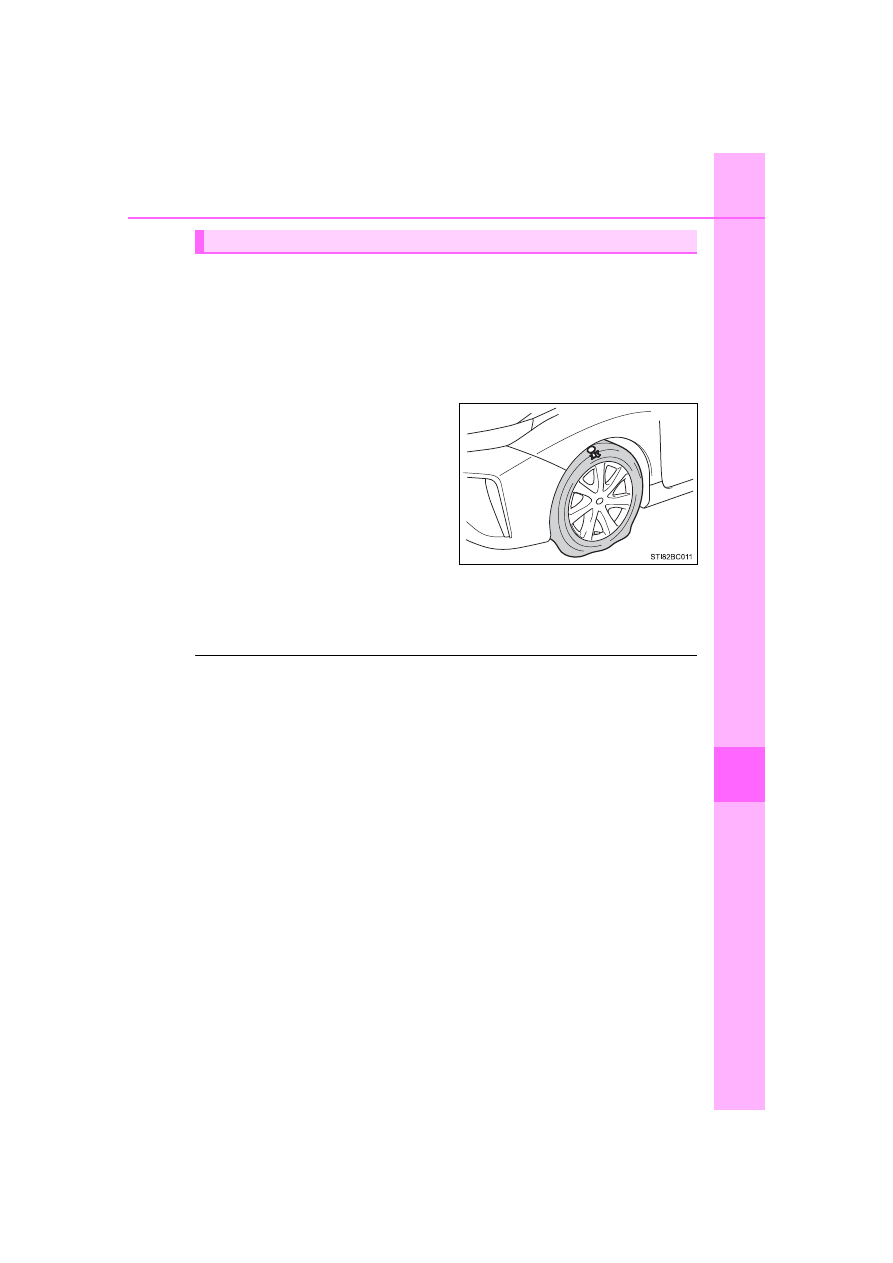
433
8-2. Steps to take in an emergency
MIRAI_OM_USA_OM62073U
8
Wh
en tro
●
Stop the vehicle in a safe place on a hard, flat surface.
●
Set the parking brake.
●
Shift the shift position to P.
●
Stop the fuel cell system.
●
Turn on the emergency flashers. (
●
Check the degree of the tire damage.
A tire should only be repaired with
the emergency tire puncture
repair kit if the damage is caused
by a nail or screw passing through
the tire tread.
• Do not remove the nail or screw
from the tire. Removing the
object may widen the opening
and
disenable
emergency
repair with the repair kit.
• To avoid sealant leakage, move the vehicle until the area of the
puncture, if known, is positioned at the top of the tire.
■
A flat tire that cannot be repaired with the emergency tire puncture
repair kit
In the following cases, the tire cannot be repaired with the emergency tire
puncture repair kit. Contact your Toyota dealer.
●
When the tire is damaged due to driving without sufficient air pressure
●
When there are any cracks or damage at any location on the tire, such
as on the side wall, except the tread
●
When the tire is visibly separated from the wheel
●
When the cut or damage to the tread is 0.16 in. (4 mm) long or more
●
When the wheel is damaged
●
When two or more tires have been punctured
●
When more than two sharp objects such as nails or screws have passed
through the tread on a single tire
●
When the sealant has expired
Before repairing the tire
-------------------------------------------------------------------------------------------------------------------------------------------------------------
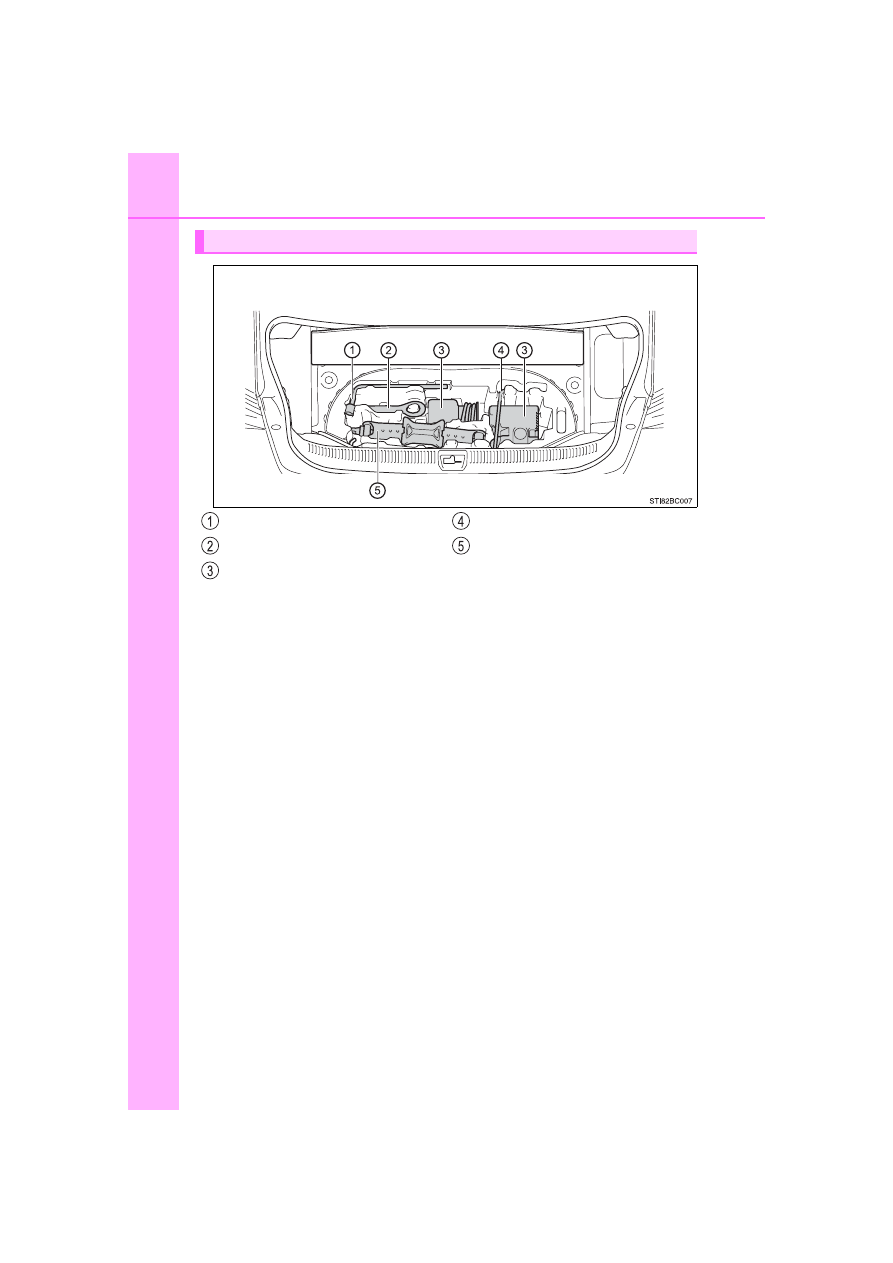
434
8-2. Steps to take in an emergency
MIRAI_OM_USA_OM62073U
Location of the emergency tire puncture repair kit, tools and jack
Wheel nut wrench
Towing eyelet
Emergency tire puncture
repair kit
*
: Use of the jack (
Jack handle
Jack
*
-------------------------------------------------------------------------------------------------------------------------------------------------------------

435
8-2. Steps to take in an emergency
MIRAI_OM_USA_OM62073U
8
Wh
en tro
Remove the luggage mat.
Remove the jack handle.
Take out the emergency tire
puncture repair kit.
Emergency tire puncture repair kit components
Hose
Air release cap
Air pressure gauge
Compressor switch
Power plug
Stickers
Taking out the emergency tire puncture repair kit
1
2
3
-------------------------------------------------------------------------------------------------------------------------------------------------------------
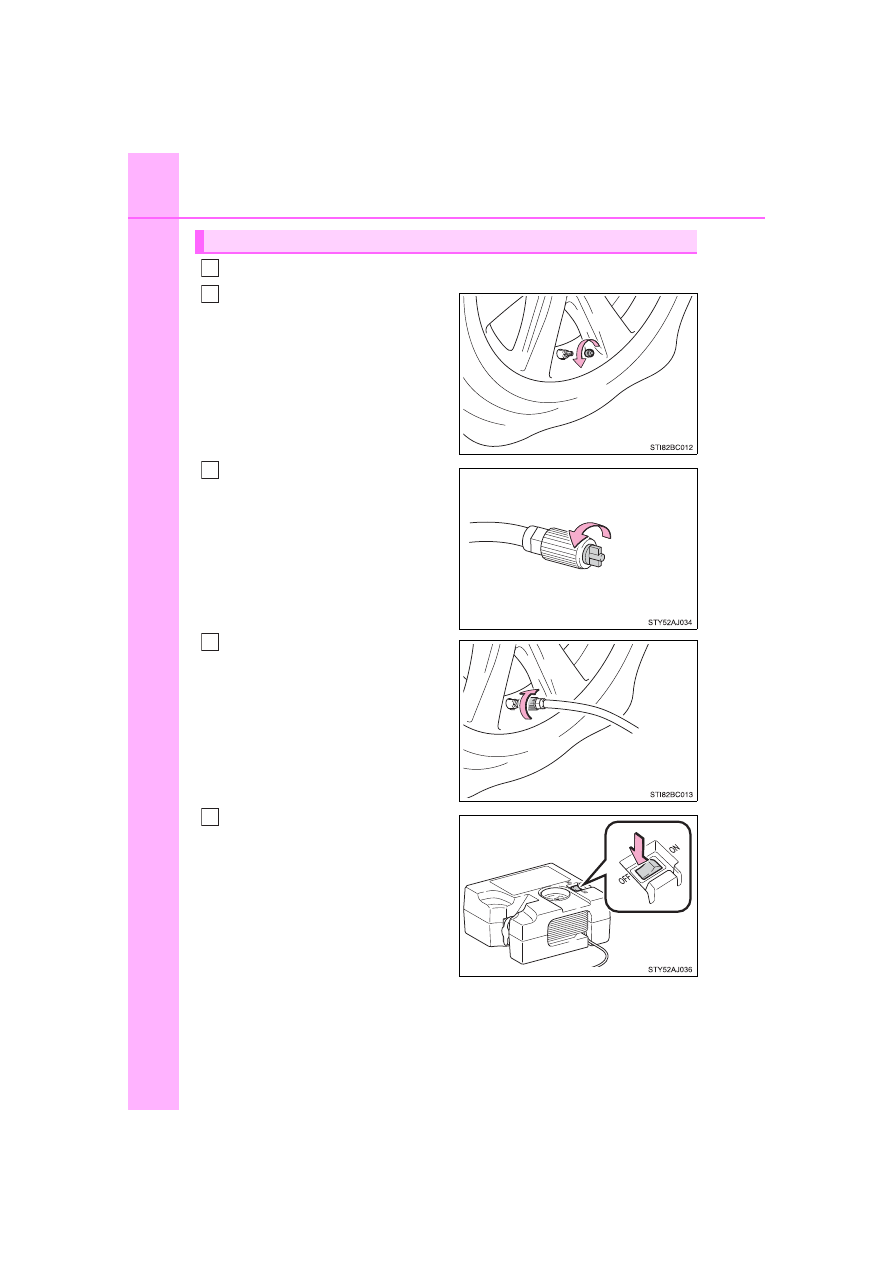
436
8-2. Steps to take in an emergency
MIRAI_OM_USA_OM62073U
Take out the repair kit from the plastic bag.
Remove the valve cap from the
valve of the punctured tire.
Remove the air release cap
from the hose.
You will use the air release cap
again. Therefore keep it in a safe
place.
Connect the hose to the valve.
Screw the end of the hose clock-
wise as far as possible.
Make sure that the compressor
switch is off.
Emergency repair method
1
2
3
4
5
-------------------------------------------------------------------------------------------------------------------------------------------------------------

437
8-2. Steps to take in an emergency
MIRAI_OM_USA_OM62073U
8
Wh
en tro
Remove the rubber stopper
from the compressor.
Connect the power plug to the
power outlet socket. (
Connect the bottle to the com-
pressor.
Make sure that the bottle is
securely connected.
6
7
8
-------------------------------------------------------------------------------------------------------------------------------------------------------------
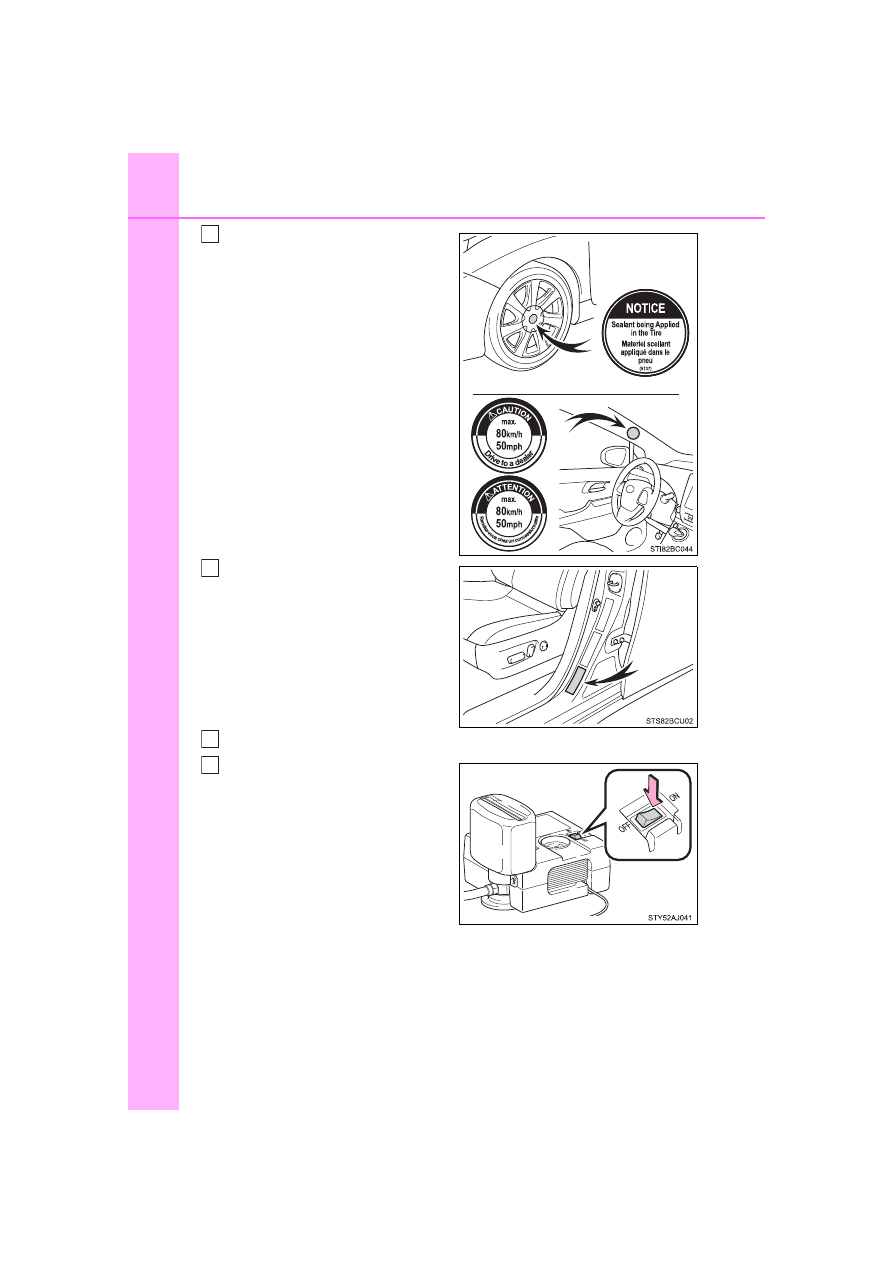
438
8-2. Steps to take in an emergency
MIRAI_OM_USA_OM62073U
Attach the 2 stickers as shown.
Remove any dirt and moisture
from the wheel before attaching
the sticker.
Check the specified tire inflation
pressure.
Tire inflation pressure is specified
on the label as shown. (
Start the fuel cell system. (
To inject the sealant and inflate
the tire, turn the compressor
switch on.
9
10
11
12
-------------------------------------------------------------------------------------------------------------------------------------------------------------
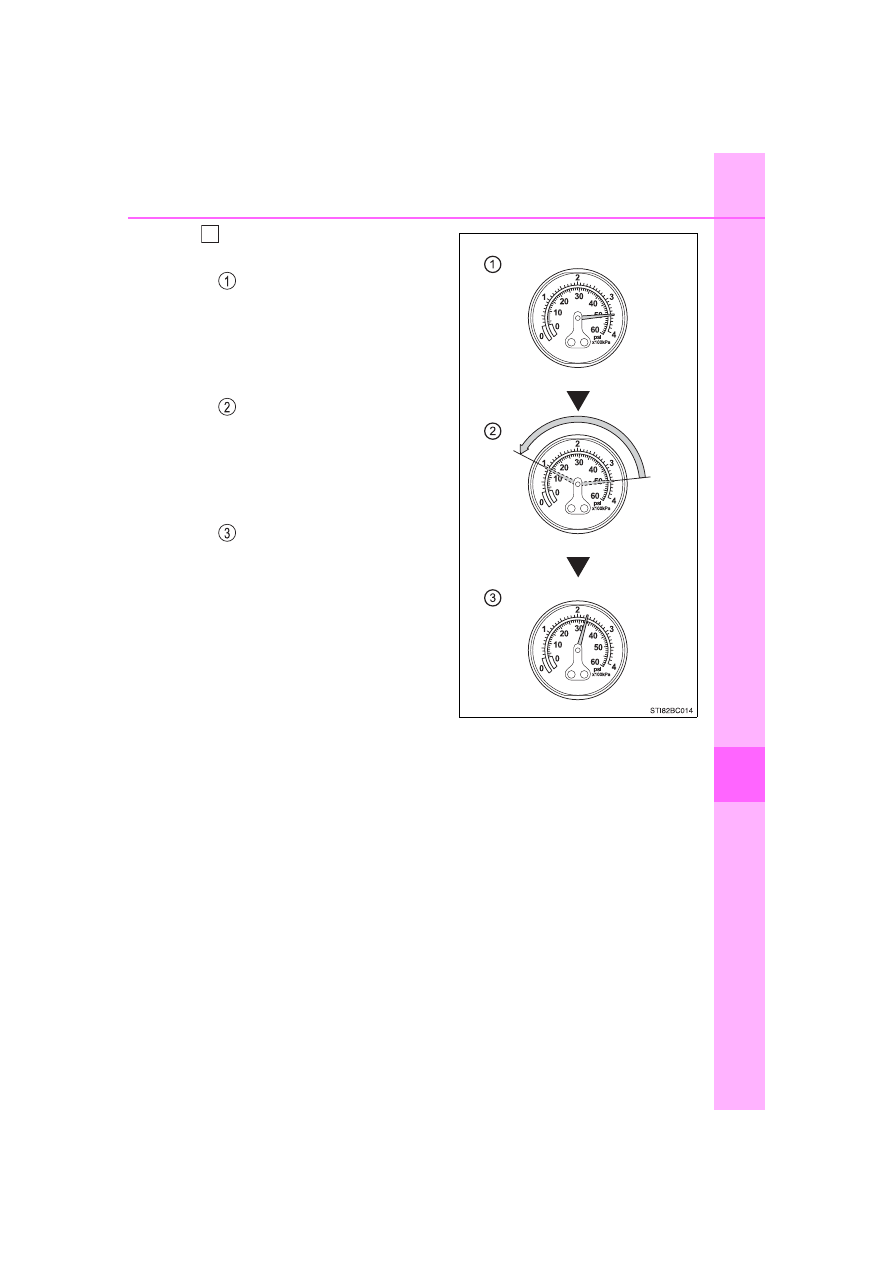
439
8-2. Steps to take in an emergency
MIRAI_OM_USA_OM62073U
8
Wh
en tro
Inflate the tire until the specified
air pressure is reached.
The sealant will be injected
and the pressure will spike to
44 psi (300 kPa, 3.1 kgf/cm
2
or bar) or 58 psi (400 kPa,
4.1 kgf/cm
2
or bar), and then
gradually decrease.
The air pressure gauge will
display the actual tire infla-
tion pressure about 1 minute
(15 minutes at low tempera-
ture) after the switch is
turned on.
Inject to specified air pres-
sure.
• Turn the compressor switch
off and then check the tire
inflation pressure. Being
careful not to over inflate,
check and repeat the infla-
tion procedure until the
specified tire inflation pres-
sure is reached.
• If the tire inflation pressure is still lower than the specified point
after inflation for 10 minutes (40 minutes at low temperature) with
the switch on, the tire is too damaged to be repaired. Turn the
compressor switch off and contact your Toyota dealer.
• If the tire inflation pressure exceeds the specified air pressure, let
out some air to adjust the tire inflation pressure. (
13
-------------------------------------------------------------------------------------------------------------------------------------------------------------

440
8-2. Steps to take in an emergency
MIRAI_OM_USA_OM62073U
With the compressor switch off, disconnect the hose from the valve
on the tire and then pull out the power plug from the power outlet
socket.
Some sealant may leak when the hose is removed.
Install the valve cap onto the valve of the emergency repaired tire.
Attach the air release cap to the
end of the hose.
If the air release cap is not
attached, the sealant may leak
and the vehicle may get dirty.
Temporarily store the bottle in the trunk while it is connected to the
compressor.
To spread the liquid sealant evenly within the tire, immediately drive
safely for about 3 miles (5 km) below 50 mph (80 km/h).
After driving for about 3 miles
(5 km), stop your vehicle in a
safe place on a hard, flat sur-
face and remove the air release
cap from the hose before
reconnecting the repair kit.
14
15
16
17
18
19
-------------------------------------------------------------------------------------------------------------------------------------------------------------
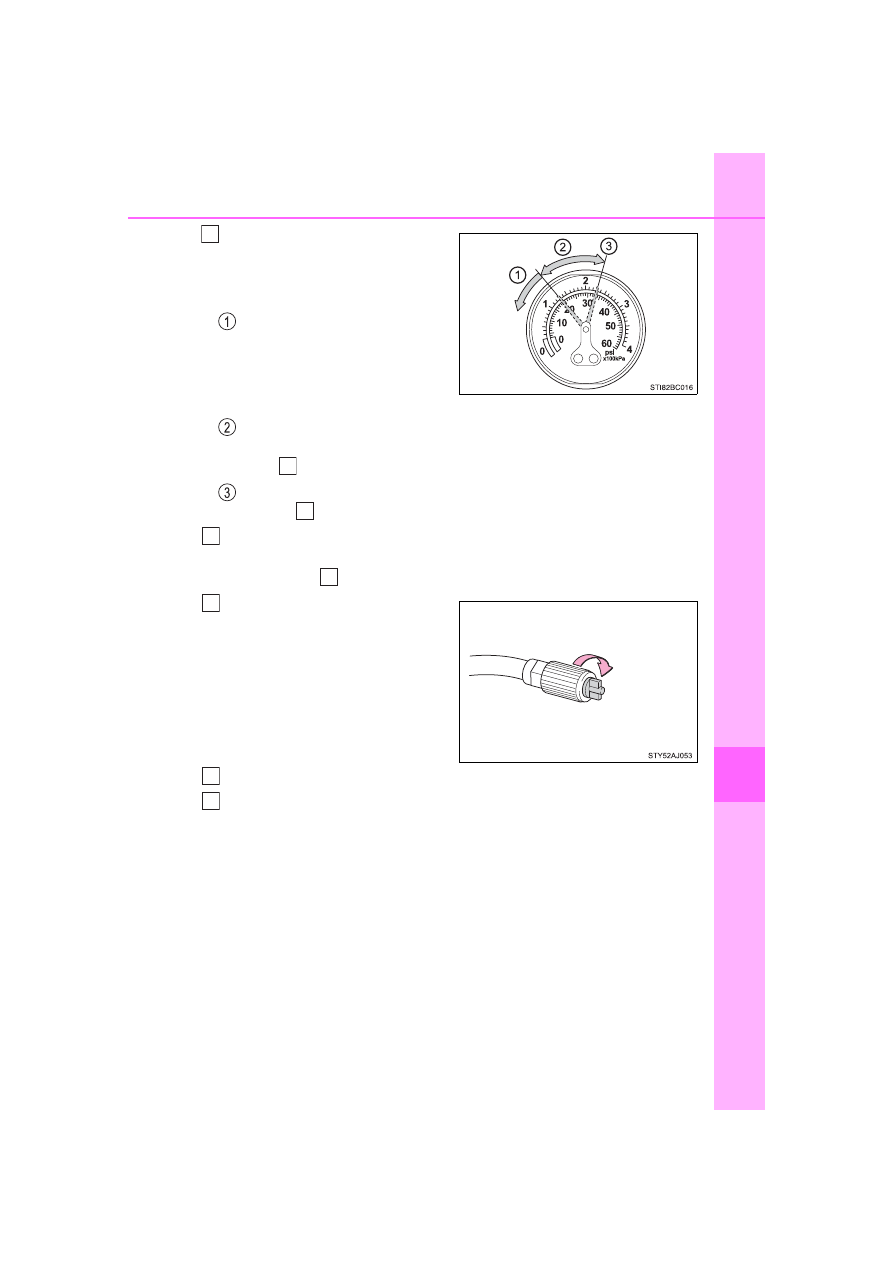
441
8-2. Steps to take in an emergency
MIRAI_OM_USA_OM62073U
8
Wh
en tro
Turn the compressor switch on
and wait for several seconds,
and then turn it off. Check the
tire inflation pressure.
If the tire inflation pressure is
under 19 psi (130 kPa,
1.3 kgf/cm
2
or bar): The
puncture cannot be repaired.
Contact your Toyota dealer.
If the tire inflation pressure is 19 psi (130 kPa, 1.3 kgf/cm
2
or bar)
or higher, but less than the specified air pressure: Proceed to
step
.
If the tire inflation pressure is the specified air pressure: Proceed
to step
.
Turn the compressor switch on to inflate the tire until the specified
air pressure is reached. Drive for about 3 miles (5 km) and then
perform step
.
Attach the air release cap to the
end of the hose.
If the air release cap is not
attached, the sealant may leak
and the vehicle may get dirty.
Store the bottle in the trunk while it is connected to the compressor.
Taking precautions to avoid sudden braking, sudden acceleration
and sharp turns, drive carefully at under 50 mph (80 km/h) to the
nearest Toyota dealer tire repair or replacement.
20
21
22
21
19
22
23
24
-------------------------------------------------------------------------------------------------------------------------------------------------------------
442
8-2. Steps to take in an emergency
MIRAI_OM_USA_OM62073U
■
Emergency tire puncture repair kit
●
The sealant stored in the emergency tire puncture repair kit can be used
only once to temporarily repair a single tire. If the sealant has been used
and needs to be replaced, purchase a new bottle at your Toyota dealer.
The compressor is reusable.
●
The sealant can be used when the outside temperature is from -40
F
(-40
C) to 140
F (60
C).
●
The repair kit is exclusively designed for size and type of tires originally
installed on your vehicle. Do not use it for tires that a different size than
the original ones, or for any other purposes.
●
The sealant has a limited lifespan. The expiry date is shown on the bot-
tle. The sealant should be replaced before the expiry date. Purchase a
new bottle at your Toyota dealer for replacement.
●
If the sealant gets on your clothes, it may stain.
●
If the sealant adheres to a wheel or the surface of the vehicle body, the
stain may not be removable if it is not cleaned at once. Immediately wipe
away the sealant with a wet cloth.
●
During operation of the repair kit, a loud operation noise is produced.
This does not indicate a malfunction.
●
Do not use to check or to adjust the tire pressure.
-------------------------------------------------------------------------------------------------------------------------------------------------------------
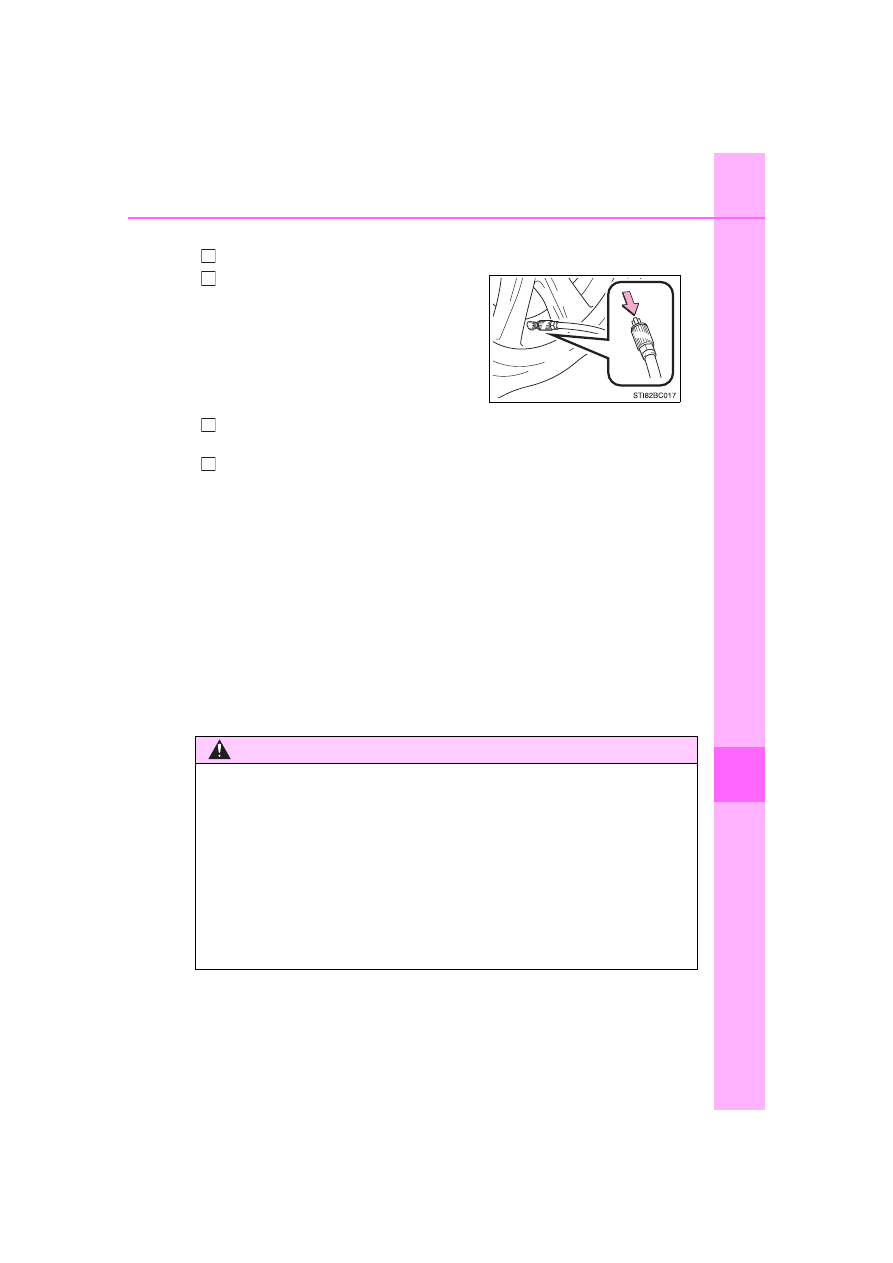
443
8-2. Steps to take in an emergency
MIRAI_OM_USA_OM62073U
8
Wh
en tro
■
If the tire is inflated to more than the specified air pressure
Disconnect the hose from the valve.
Disconnect the hose from the valve, remove the air release cap from
the hose and then reconnect the hose.
Turn the compressor switch on and wait for several seconds, then turn
it off. Check that the air pressure indicator shows the specified air pres-
sure. (
If the air pressure is under the designated pressure, turn the compres-
sor switch on again and repeat the inflation procedure until the speci-
fied air pressure is reached.
■
After a tire is repaired with the emergency tire puncture repair kit
●
The tire pressure warning valve and transmitter should be replaced.
●
Even if the tire inflation pressure is at the recommended level, the tire
pressure warning light may come on/flash.
■
Note for checking the emergency tire puncture repair kit
Check the sealant expiry date occasionally.
The expiry date is shown on the bottle. Do not use sealant whose expiry
date has already passed. Otherwise, repairs conducted using the emer-
gency tire puncture repair kit may not be performed properly.
Install the air release cap to the end of
the hose and push the protrusion on
the air release cap into the tire valve
to let some air out.
WARNING
■
Caution while driving
●
Store the repair kit in the trunk.
Otherwise, the repair kit may fly out and break in events such as sud-
den braking, and may cause an accident.
●
The repair kit is exclusively only for your vehicle.
Do not use repair kit on other vehicles, which could lead to an accident
causing death or serious injury.
●
Do not use repair kit for tires that are different size than the original
ones, or for any other purpose. If the tires have not been completely
repaired, it could lead to an accident causing death or serious injury.
1
2
3
4
-------------------------------------------------------------------------------------------------------------------------------------------------------------
444
8-2. Steps to take in an emergency
MIRAI_OM_USA_OM62073U
WARNING
■
Precautions for use of the sealant
●
Ingesting the sealant is hazardous to your health. If you ingest sealant,
consume as much water as possible, and then immediately consult a
doctor.
●
If sealant gets in eyes or adheres to skin, immediately wash it off with
water. If discomfort persists, consult a doctor.
■
When fixing the flat tire
●
Stop your vehicle in a safe and flat area.
●
Do not touch the wheels or the area around the brakes immediately
after the vehicle has been driven.
After the vehicle has been driven, the wheels and the area around the
brakes may be extremely hot. Touching these areas with hands, feet or
other body parts may result in burns.
●
Connect the valve and hose securely with the tire installed on the vehi-
cle.
●
If the hose is not properly connected to the valve, air leakage may
occur or sealant may be sprayed out.
●
Follow the operation procedure to repair the tire. If the procedures are
not followed, the sealant may spray out.
●
If the hose comes off the valve while inflating the tire, there is a risk
that the hose will move abruptly due to air pressure.
●
After inflation of the tire has completed, the sealant may splatter when
the hose is disconnected or some air is let out of the tire.
●
Keep back from the tire while it is being repaired, as there is a chance
of it bursting while the repair operation is being performed. If you
notice any cracks or deformation of the tire, turn off the compressor
switch and stop the repair operation immediately.
●
The repair kit may overheat if operated for a long period of time. Do not
operate the repair kit continuously for more than 40 minutes.
●
Parts of the repair kit become hot during operation. Be careful handling
the repair kit during and after operation. Do not touch the metal part
connecting the bottle and the compressor. It will be extremely hot.
●
Do not attach the vehicle speed warning sticker to an area other than
the one indicated. If the sticker is attached to an area where an SRS
airbag is located, such as the pad of the steering wheel, it may prevent
the SRS airbag from operating properly.
-------------------------------------------------------------------------------------------------------------------------------------------------------------
445
8-2. Steps to take in an emergency
MIRAI_OM_USA_OM62073U
8
Wh
en tro
WARNING
■
D
riving to spread the liquid sealant evenly
Observe the following precautions to reduce the risk of accidents.
Failure to do so may result in a loss of vehicle control and cause death
or serious injury.
●
Drive the vehicle carefully at a low speed. Be especially careful when
turning and cornering.
●
If the vehicle does not drive straight or you feel a pull through the
steering wheel, stop the vehicle and check the following:
• Tire condition. The tire may have separated from the wheel.
• Tire inflation pressure. If tire inflation pressure is 19 psi (130 kPa,
1.3 kgf/cm
2
or bar) or less, this may indicate severe tire damage.
-------------------------------------------------------------------------------------------------------------------------------------------------------------
446
8-2. Steps to take in an emergency
MIRAI_OM_USA_OM62073U
NOTICE
■
When performing an emergency repair
●
A tire should only be repaired with the emergency tire puncture repair
kit if the damage is caused by a sharp object such as nail or screw
passing through the tire tread.
Do not remove the sharp object from the tire. Removing the object may
widen the opening and disenable emergency repair with the repair kit.
●
The repair kit is not waterproof. Make sure that the repair kit is not
exposed to water, such as when it is being used in the rain.
●
Do not put the repair kit directly onto dusty ground such as sand at the
side of the road. If the repair kit vacuums up dust etc., a malfunction
may occur.
■
Handling the emergency tire puncture repair kit
●
The repair kit power source should be 12 V DC suitable for vehicle
use. Do not connect the repair kit to any other source.
●
If organic substances such as benzene or gasoline splatters on the
repair kit, the repair kit may deteriorate. Take care not to allow organic
substances to contact it.
●
Place the repair kit in a storage to prevent it from being exposed to dirt
or water.
●
Store the repair kit in the assigned place out of reach of children.
●
Do not disassemble or modify the repair kit. Do not subject parts such
as the air pressure indicator to impacts. This may cause a malfunction.
■
To avoid damage to the tire pressure warning valves and transmit-
ters
When a tire is repaired with liquid sealants, the tire pressure warning
valve and transmitter may not operate properly. If a liquid sealant is
used, contact your Toyota dealer as soon as possible. After use of liquid
sealant, make sure to replace the tire pressure warning valve and trans-
mitter when repairing or replacing the tire. (
-------------------------------------------------------------------------------------------------------------------------------------------------------------
447
8-2. Steps to take in an emergency
MIRAI_OM_USA_OM62073U
8
Wh
en tro
If the fuel cell system will not start
One of the following may be the cause of the problem:
●
The electronic key may not be functioning properly. (
●
There may not be sufficient fuel in the vehicle’s tank.
Refuel the vehicle.
●
The fuel door may be open. (
●
There may be a malfunction in the immobilizer system.
(
●
There may be a malfunction in the shift control system.
*
(
●
The fuel cell system may be malfunctioning due to an electrical
problem such as electronic key battery depletion or a blown fuse.
However, depending on the type of malfunction, an interim mea-
sure is available to start the fuel cell system. (
●
The electronic key may be in battery-saving mode. (
*
: It may not be possible to shift the shift position from P to another position.
One of the following may be the cause of the problem:
●
The 12-volt battery may be discharged. (
●
The 12-volt battery terminal connections may be loose or corroded.
(
Reasons for the fuel cell system not starting vary depending on
the situation. Check the following and perform the appropriate
procedure:
The fuel cell system will not start even though the correct start-
ing procedure is being followed. (
The interior lights and headlights are dim, or the horn does not
sound or sounds at a low volume.
-------------------------------------------------------------------------------------------------------------------------------------------------------------
448
8-2. Steps to take in an emergency
MIRAI_OM_USA_OM62073U
One of the following may be the cause of the problem:
●
The 12-volt battery may be discharged. (
●
One or both of the 12-volt battery terminals may be disconnected.
Contact your Toyota dealer if the problem cannot be repaired, or if repair
procedures are unknown.
When the fuel cell system does not start, the following steps can be
used as an interim measure to start the fuel cell system if the power
switch is functioning normally.
Do not use this starting procedure except in case of emergency.
Set the parking brake.
Turn the power switch to ACCESSORY mode.
Press and hold the power switch for about 15 seconds while
depressing the brake pedal firmly.
Even if the fuel cell system can be started using the above steps, the
system may be malfunctioning. Have the vehicle inspected by your
Toyota dealer.
The interior lights and headlights do not turn on, or the horn
does not sound.
Emergency start function
1
2
3
-------------------------------------------------------------------------------------------------------------------------------------------------------------
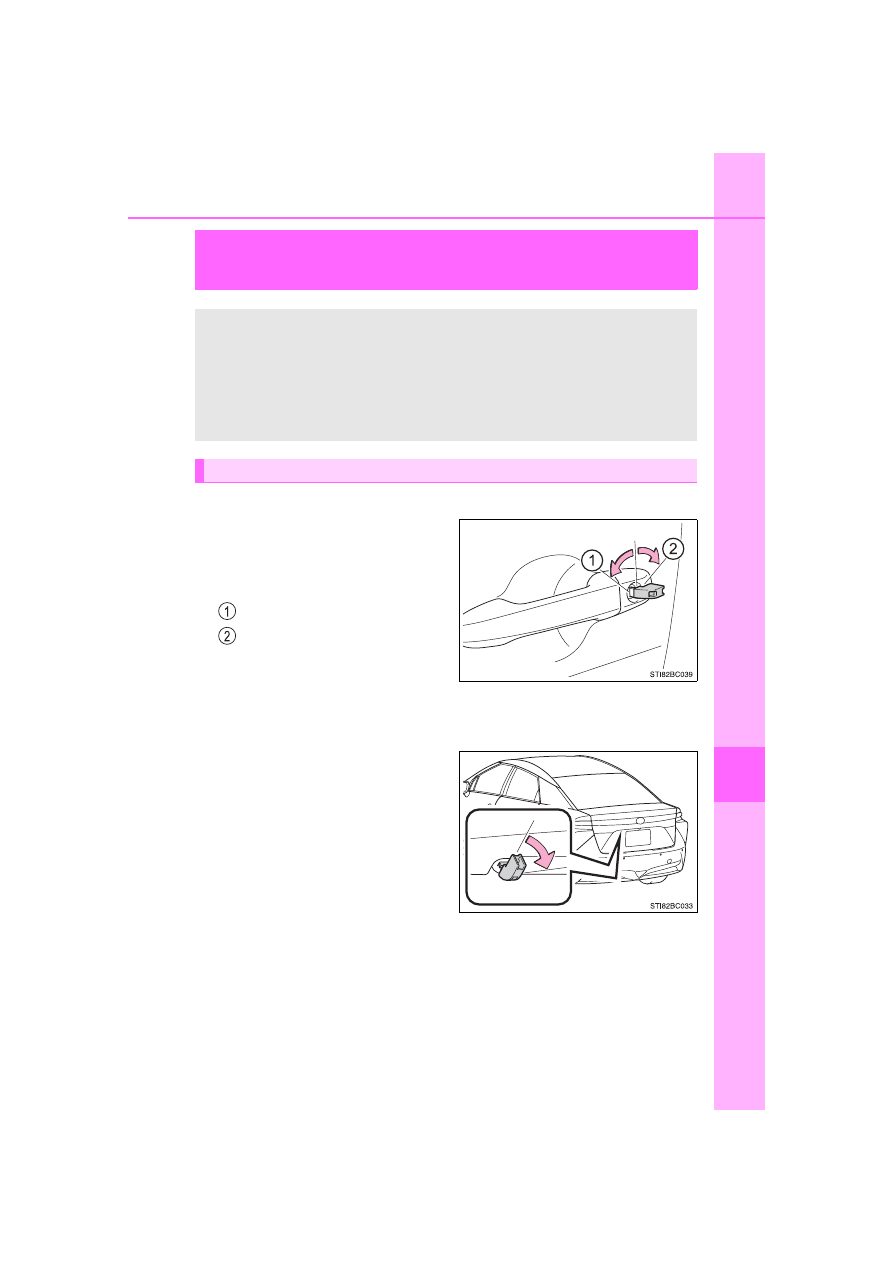
449
8-2. Steps to take in an emergency
MIRAI_OM_USA_OM62073U
8
Wh
en tro
If the electronic key does not operate
properly
■
Doors
Use the mechanical key
(
P. 129) in order to perform
the
following
operations
(driver’s door only):
Locks all doors
Unlocks the door
Turning the key rearward
unlocks the driver’s door. Turn-
ing the key once again unlocks
the other doors.
■
Trunk
Turn the mechanical key clock-
wise to open.
If communication between the electronic key and vehicle is
interrupted (
P. 146) or the electronic key cannot be used
because the battery is depleted, the smart key system and wire-
less remote control cannot be used. In such cases, the doors
can be opened and the fuel cell system can be started by follow-
ing the procedure below.
Locking and unlocking the doors
-------------------------------------------------------------------------------------------------------------------------------------------------------------
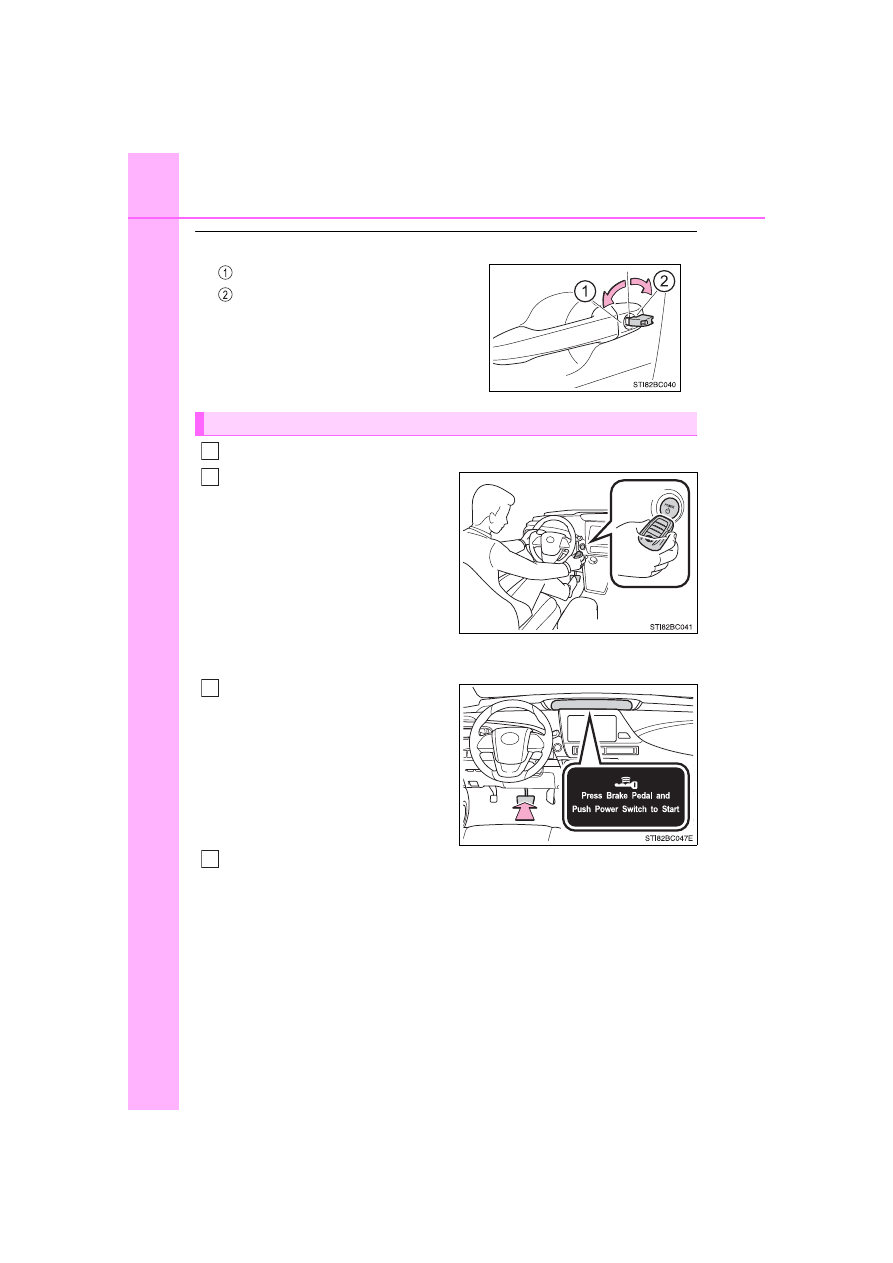
450
8-2. Steps to take in an emergency
MIRAI_OM_USA_OM62073U
■
Key linked functions
Depress the brake pedal.
Touch the power switch with the
Toyota emblem side of the elec-
tronic key facing away from the
switch.
When the electronic key is
detected, a buzzer sounds and the
power switch will turn to ON mode.
When the smart key system is
deactivated in customization set-
ting, the power switch will turn to
ACCESSORY mode.
Firmly depress the brake pedal
and check that message is dis-
played on the multi-information
display.
Press the power switch.
In the event that the fuel cell system still cannot be started, contact
your Toyota dealer.
Closes the windows
*
(turn and hold)
Opens the windows
*
(turn and hold)
*
: These settings must be customized at
your Toyota dealer. (
Starting the fuel cell system
1
2
3
4
-------------------------------------------------------------------------------------------------------------------------------------------------------------
451
8-2. Steps to take in an emergency
MIRAI_OM_USA_OM62073U
8
Wh
en tro
■
Stopping the fuel cell system
Shift the shift position to P and press the power switch as you normally do
when stopping the fuel cell system.
■
Replacing the key battery
As the above procedure is a temporary measure, it is recommended that the
electronic key battery be replaced immediately when the battery is depleted.
(
■
Alarm
Using the mechanical key to lock the doors will not set the alarm system.
If a door is unlocked using the mechanical key when the alarm system is set,
the alarm may be triggered. (
■
When the electronic key does not work properly
●
Make sure that the smart key system has not been deactivated in the cus-
tomization setting. If it is off, turn the function on.
(Customizable features
●
Check if battery-saving mode is set. If it is set, cancel the function.
(
■
Changing power switch modes
Release the brake pedal and press the power switch in step
above.
The fuel cell system does not start and modes will be changed each time the
switch is pressed. (
WARNING
■
When using the mechanical key and operating the power windows
Operate the power window after checking to make sure that there is no pos-
sibility of any passenger having any of their body parts caught in the win-
dow.
Also, do not allow children to operate the mechanical key. It is possible for
children and other passengers to get caught in the power window.
3
-------------------------------------------------------------------------------------------------------------------------------------------------------------
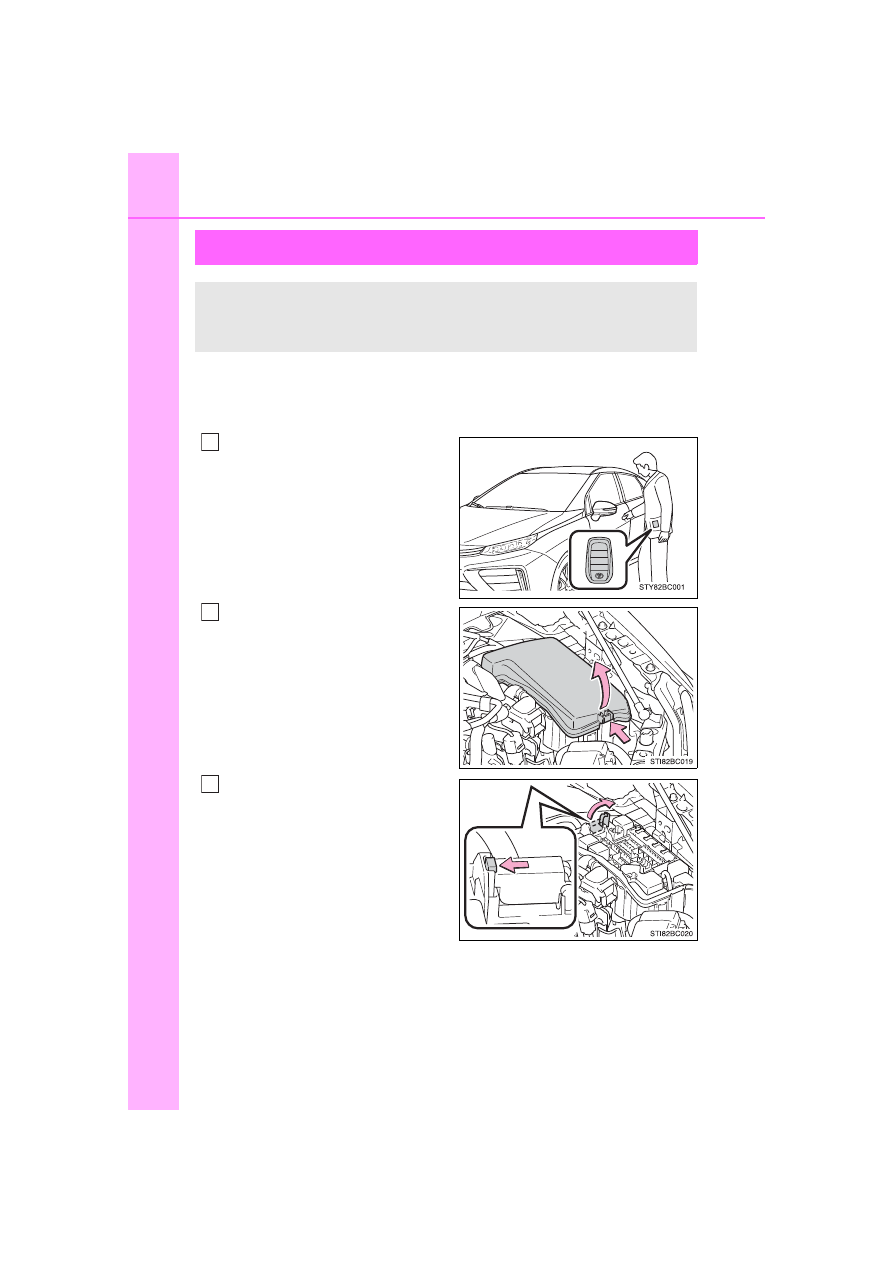
452
8-2. Steps to take in an emergency
MIRAI_OM_USA_OM62073U
If the 12-volt battery is discharged
If you have a set of jumper (or booster) cables and a second vehicle
with a 12-volt battery, you can jump start your vehicle by following the
steps below.
Confirm that the electronic key
is being carried.
When connecting the jumper (or
booster) cables, depending on the
situation, the alarm may activate
and the doors may lock. (
Open the hood (
P. 366) and
fuse box cover.
Open the exclusive jump start-
ing terminal cover.
The following procedures may be used to start the fuel cell sys-
tem if the 12-volt battery is discharged.
You can also call your Toyota dealer or a qualified repair shop.
1
2
3
-------------------------------------------------------------------------------------------------------------------------------------------------------------
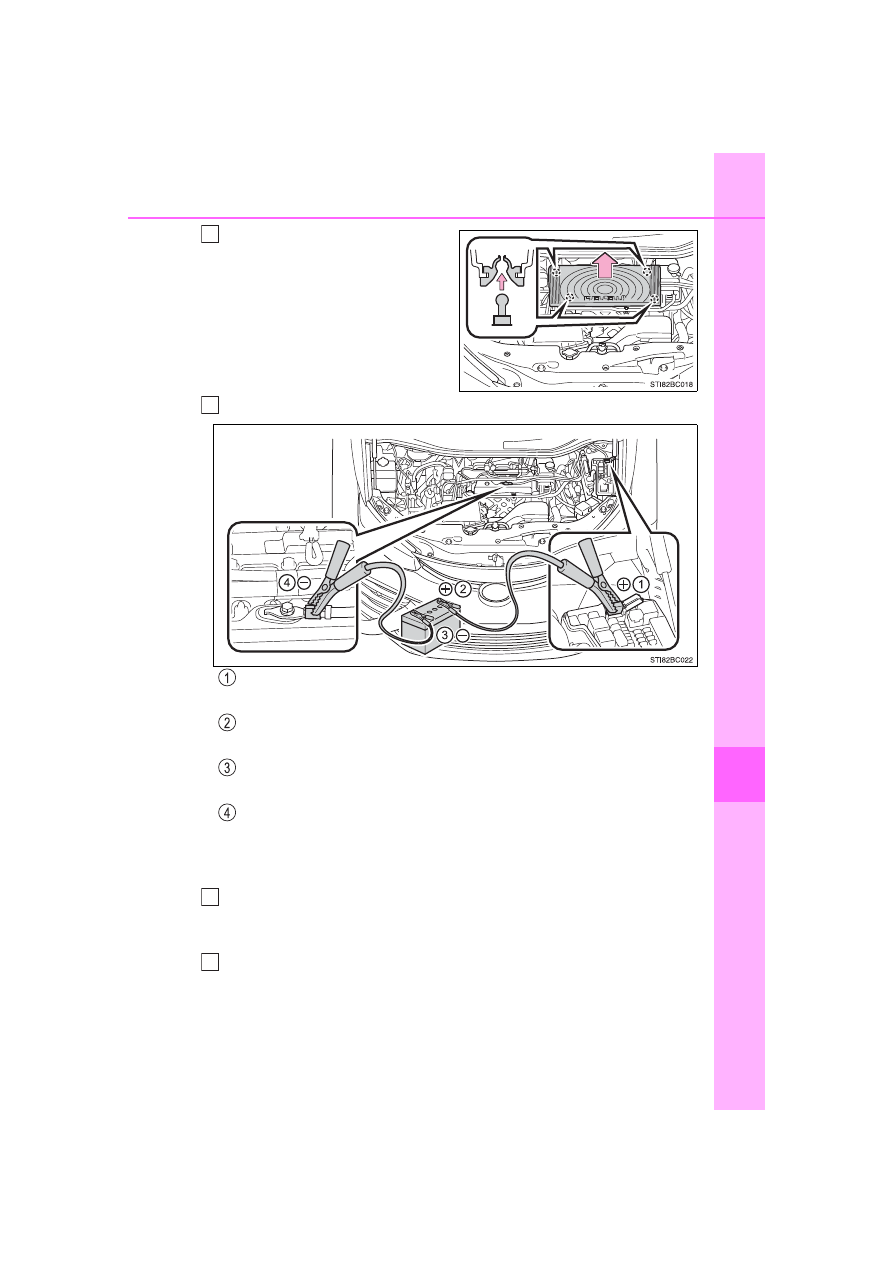
453
8-2. Steps to take in an emergency
MIRAI_OM_USA_OM62073U
8
Wh
en tro
Remove the motor cover.
Connect the jumper cables according to the following procedure:
Connect a positive jumper cable clamp to the exclusive jump
starting terminal on your vehicle.
Connect the clamp on the other end of the positive cable to the
positive (+) battery terminal on the second vehicle.
Connect a negative cable clamp to the negative (-) battery termi-
nal on the second vehicle.
Connect the clamp at the other end of the negative cable to a
solid, stationary, unpainted metallic point away from the exclusive
jump starting terminal and any moving parts, as shown in the
illustration.
Start the engine of the second vehicle. Increase the engine speed
slightly and maintain at that level for approximately 5 minutes to
recharge the 12-volt battery of your vehicle.
Maintain the engine speed of the second vehicle and start the fuel
cell system of your vehicle by turning the power switch to ON mode.
4
5
6
7
-------------------------------------------------------------------------------------------------------------------------------------------------------------

454
8-2. Steps to take in an emergency
MIRAI_OM_USA_OM62073U
Make sure the “READY” indicator comes on. If the indicator does
not come on, contact your Toyota dealer.
Once the fuel cell system has started, remove the jumper cables in
the exact reverse order from which they were connected.
Close the exclusive jump starting terminal cover, reinstall the motor
cover and the fuse box cover to its original position.
Once the fuel cell system starts, have the vehicle inspected at your
Toyota dealer as soon as possible.
■
Starting the fuel cell system when the 12-volt battery is discharged
The fuel cell system cannot be started by push-starting.
■
To prevent 12-volt battery discharge
●
Turn off the headlights and the audio system while the fuel cell system is off.
●
Turn off any unnecessary electrical components when the vehicle is running
at a low speed for an extended period, such as in heavy traffic.
■
Charging the 12-volt battery
The electricity stored in the 12-volt battery will discharge gradually even when
the vehicle is not in use, due to natural discharge and the draining effects of
certain electrical appliances. If the vehicle is left for a long time, the 12-volt
battery may discharge, and the fuel cell system may be unable to start. (The
12-volt battery recharges automatically while the fuel cell system is operat-
ing.)
■
When the 12-volt battery is removed or discharged
●
In some cases, it may not be possible to unlock the doors using the smart
key system when the 12-volt battery is discharged. Use the wireless remote
control or the mechanical key to lock or unlock the doors.
●
The fuel cell system may not start on the first attempt after the 12-volt bat-
tery has recharged but will start normally after the second attempt. This is
not a malfunction.
●
The power switch mode is memorized by the vehicle. When the 12-volt bat-
tery is reconnected, the system will return to the mode it was in before the
12-volt battery was discharged. Before disconnecting the 12-volt battery,
turn the power switch off.
If you are unsure what mode the power switch was in before the 12-volt bat-
tery discharged, be especially careful when reconnecting the 12-volt battery.
●
If the 12-volt battery is depleted with the shift position in P, it will not be pos-
sible to shift the shift position other than P. In this case, the vehicle cannot
be towed without lifting both front wheels because the front wheels are
locked by the parking lock. (
8
9
10
-------------------------------------------------------------------------------------------------------------------------------------------------------------
455
8-2. Steps to take in an emergency
MIRAI_OM_USA_OM62073U
8
Wh
en tro
●
When the 12-volt battery is reconnected, start the fuel cell system, depress
the brake pedal, and confirm that it is possible to shift into each shift posi-
tion.
●
If the battery is removed or the terminals disconnected without operating the
water release function during cold weather, the vehicle may not start due to
the fuel cell system being frozen. To prevent this, operate the water release
function before removing the battery or disconnecting the terminals.
(
■
When exchanging the 12-volt battery
Use a Central Degassing type 12-volt battery (Japanese Industrial Stan-
dards). Also, use 12-volt batteries with case sizes similar to one prior the
exchange and an equivalent 20 hour rate capacity (20HR) or greater.
• If the sizes differ, the 12-volt battery cannot be properly secured.
• If the 20 hour rate capacity is low, even if the time period where the vehicle
is not used is a short time, the 12-volt battery may discharge and fuel cell
system may not be able to start.
For details, consult your Toyota dealer.
WARNING
■
Avoiding 12-volt battery fires or explosions
Observe the following precautions to prevent accidentally igniting the flam-
mable gas that may be emitted from the 12-volt battery:
●
Make sure each jumper cable is connected to the correct terminal and that
it is not unintentionally in contact with any other than the intended terminal.
●
Do not allow the other end of the jumper cable connected to the “+” termi-
nal to come into contact with any other parts or metal surfaces in the area,
such as brackets or unpainted metal.
●
Do not allow the + and - clamps of the jumper cables to come into contact
with each other.
●
Do not smoke, use matches, cigarette lighters or allow open flame near
the 12-volt battery.
-------------------------------------------------------------------------------------------------------------------------------------------------------------
456
8-2. Steps to take in an emergency
MIRAI_OM_USA_OM62073U
WARNING
■
12-volt battery precautions
The 12-volt battery contains poisonous and corrosive acidic electrolyte,
while related parts contain lead and lead compounds. Observe the following
precautions when handling the 12-volt battery:
●
When working with the 12-volt battery, always wear safety glasses and
take care not to allow any 12-volt battery fluids (acid) to come into contact
with skin, clothing or the vehicle body.
●
Do not lean over the 12-volt battery.
●
In the event that 12-volt battery fluid comes into contact with the skin or
eyes, immediately wash the affected area with water and seek medical
attention.
Place a wet sponge or cloth over the affected area until medical attention
can be received.
●
Always wash your hands after handling the 12-volt battery support, termi-
nals, and other battery-related parts.
●
Do not allow children near the 12-volt battery.
■
After recharging the 12-volt battery
Have the 12-volt battery inspected at your Toyota dealer as soon as possi-
ble.
If the 12-volt battery is deteriorating, continued use may cause the 12-volt
battery to emit a malodorous gas, which may be detrimental to the health of
passengers.
■
When exchanging the 12-volt battery
After exchanging, securely attach the exhaust hose and exhaust hole plug
to the exhaust hole of the exchanged 12-volt battery. If not properly
installed, gases (hydrogen) may leak into the vehicle interior, and there is
the possible danger of the gas igniting and exploding.
■
When replacing the 12-volt battery
NOTICE
■
To prevent damaging the vehicle
The exclusive jump starting terminal is to be used when charging the 12-volt
battery from another vehicle in an emergency. It cannot be used to jump
start another vehicle.
■
When handling jumper cables
When connecting the jumper cables, ensure that they do not become entan-
gled in the cooling fans.
-------------------------------------------------------------------------------------------------------------------------------------------------------------
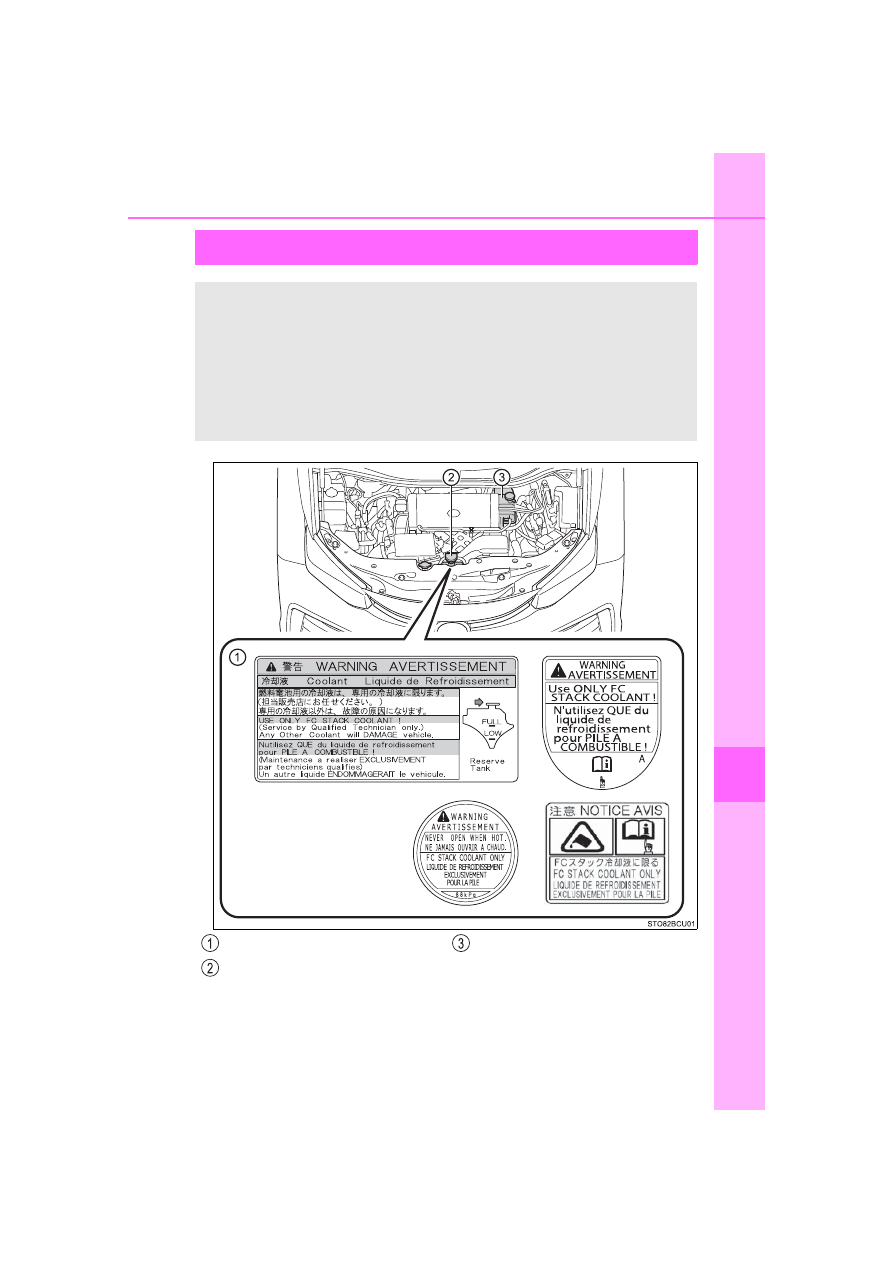
457
8-2. Steps to take in an emergency
MIRAI_OM_USA_OM62073U
8
Wh
en tro
If your vehicle overheats
The following may indicate that your vehicle is overheating.
●
The high coolant temperature warning light (
P. 418) comes on
or flashes, or a loss of fuel cell system power is experienced. (For
example, the vehicle speed does not increase.)
●
“FC System Overheat Output Power is Limited” (
P. 426) is dis-
played on the multi-information display
●
Steam comes out from under the hood.
Label
Fuel cell stack coolant
reservoir
Inverter coolant reservoir
-------------------------------------------------------------------------------------------------------------------------------------------------------------

458
8-2. Steps to take in an emergency
MIRAI_OM_USA_OM62073U
■
If the high coolant temperature warning light comes on or
flashes
Stop the vehicle in a safe place and turn off the air conditioning sys-
tem, and then stop the fuel cell system.
If you see steam or coolant leaks:
Carefully lift the hood after the steam subsides.
If you do not see steam or coolant leaks:
Carefully lift the hood.
After the fuel cell system has
cooled
down
sufficiently,
inspect the hoses and radiator
core (radiator) for any leaks.
Fuel cell stack coolant sub
radiator
Fuel cell stack coolant radia-
tor
Electric cooling fans
If a large amount of coolant leaks, immediately contact your Toyota
dealer.
NOTICE
Correction procedures
The fuel cell stack coolant is exclusive for
fuel cell stack usage. Damage may occur
when water or any other type of coolant
is used, so never use any other fluid.
If the fuel cell stack coolant is low, imme-
diately contact your Toyota dealer.
1
2
3
-------------------------------------------------------------------------------------------------------------------------------------------------------------

459
8-2. Steps to take in an emergency
MIRAI_OM_USA_OM62073U
8
Wh
en tro
The fuel cell stack coolant level
is satisfactory if it is between
the “FULL” and “LOW” lines on
the reservoir.
Fuel cell stack coolant reser-
voir
“FULL” line
“LOW” line
If the amount of fuel cell stack coolant is low:
Immediately contact your Toyota dealer.
If the amount of fuel cell stack coolant is not low:
Have the vehicle inspected at the nearest Toyota dealer.
Even if the fuel cell stack cool-
ant is low, do not refill it.
4
-------------------------------------------------------------------------------------------------------------------------------------------------------------
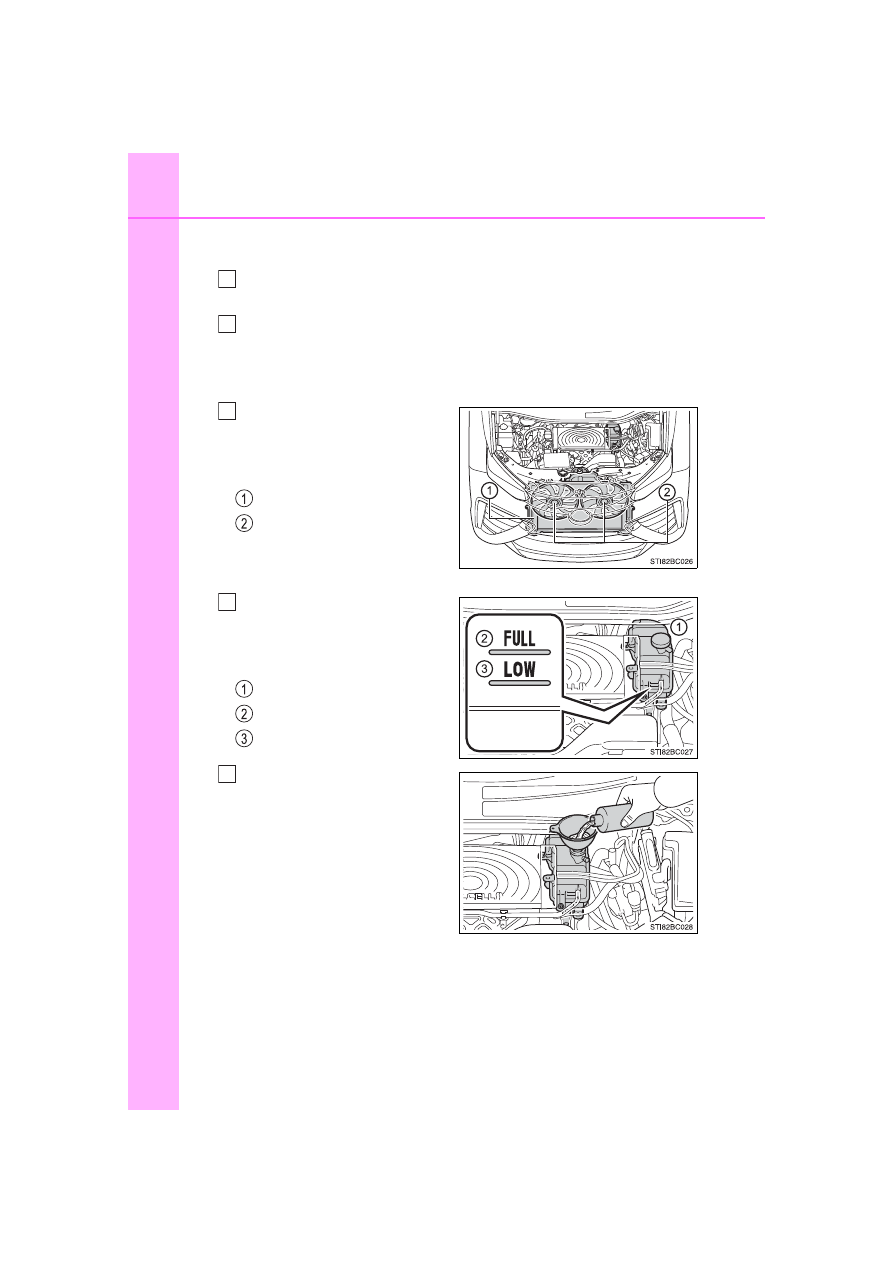
460
8-2. Steps to take in an emergency
MIRAI_OM_USA_OM62073U
■
If “FC System Overheat Output Power is Limited” is displayed
on the multi-information display
Stop the vehicle in a safe place and turn off the air conditioning
system, and then stop the fuel cell system.
If you see steam or coolant leaks:
Carefully lift the hood after the steam subsides.
If you do not see steam or coolant leaks:
Carefully lift the hood.
After the fuel cell system has
cooled down, inspect the
hoses and radiator core
(radiator) for any leaks.
Inverter coolant radiator
Electric cooling fans
If a large amount of coolant
leaks, immediately contact
your Toyota dealer.
The inverter coolant level is
satisfactory if it is between
the “FULL” and “LOW” lines
on the reservoir.
Inverter coolant reservoir
“FULL”
“LOW”
Add inverter coolant if neces-
sary.
Water can be used in an emer-
gency if inverter coolant is
unavailable.
1
2
3
4
5
-------------------------------------------------------------------------------------------------------------------------------------------------------------
461
8-2. Steps to take in an emergency
MIRAI_OM_USA_OM62073U
8
Wh
en tro
Start the fuel cell system and turn the air conditioning system on
to check that the radiator cooling fans operate and to check for
coolant leaks from the radiator or hoses.
The fans operate when the air conditioning system is turned on immedi-
ately after a cold start. Confirm that the fans are operating by checking
the fan sound and air flow. If it is difficult to check these, turn the air con-
ditioning system on and off repeatedly.
(The fans may not operate in freezing temperatures.)
If the fans are not operating:
Stop the fuel cell system immediately and contact your Toyota
dealer.
If the fans are operating:
Have the vehicle inspected at the nearest Toyota dealer.
WARNING
■
When inspecting under the hood of your vehicle
Observe the following precautions.
Failure to do so may result in serious injury such as burns.
●
If steam is seen coming from under the hood, do not open the hood until
the steam has subsided. The motor compartment may be very hot.
●
After the fuel cell system has been turned off, check that the “READY”
indicator is off.
When the fuel cell system is operating, the cooling fans may suddenly
operate even if the fuel cell system stops. Do not touch or approach rotat-
ing parts such as the fans, which may lead to fingers or clothing (espe-
cially a tie, a scarf or a muffler) getting caught, resulting in serious injury.
●
Do not loosen the coolant reservoir caps or radiator cap, while the fuel cell
system and radiator are hot.
High temperature steam or coolant could spray out.
6
7
-------------------------------------------------------------------------------------------------------------------------------------------------------------

Нет комментариевНе стесняйтесь поделиться с нами вашим ценным мнением.
Текст